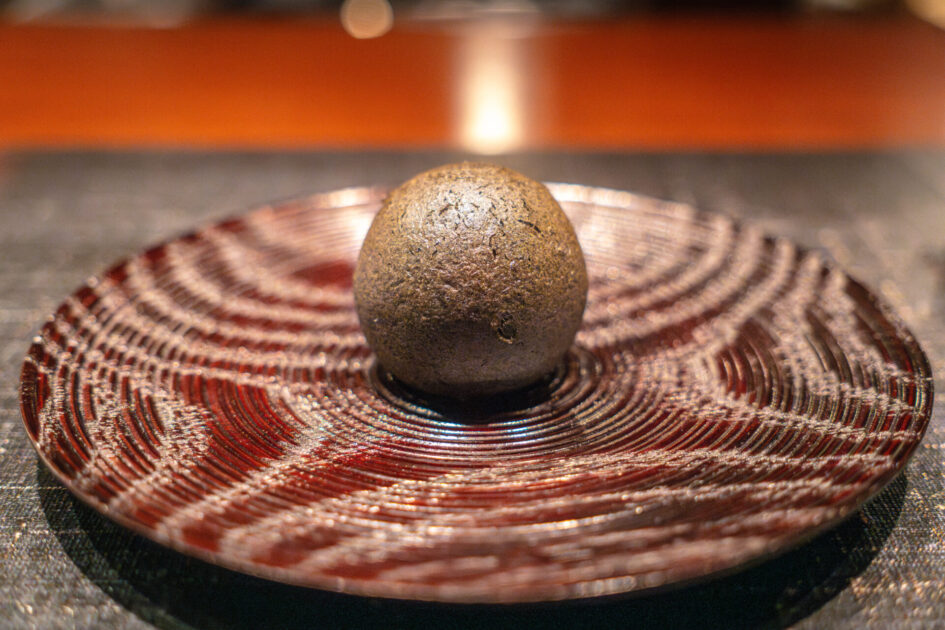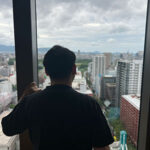CONTENTS
About Narayamachi Ao
Concept
In the quiet backstreets of Narayamachi, Fukuoka, a gentle light glows from a house—Ao.
Chef Hideyuki Kaneda helms this discreet restaurant, offering a course menu rooted in Japanese cuisine while subtly infused with French culinary techniques and sensibilities shaped by his travels.
Seasonal ingredients from across Kyushu take center stage. With a delicate layering of aroma, temperature, and texture, some dishes even incorporate gestures of the diner—wrapping, breaking, or scooping by hand—turning the meal into a flowing experience rather than a series of plated items.
The style avoids theatrical flair, instead speaking with a sense of spaciousness and restraint. From the precision of heat control to the quiet of plating and the rhythm of the space itself, everything is honed with refinement—nothing excessive, nothing lacking. It’s all governed by a clear aesthetic sensibility.
The dishes speak for themselves. Without explanation, the values behind them are conveyed from the plate.
As the name Ao—meaning “blue”—suggests, what lingers is a quiet, profound culinary memory.
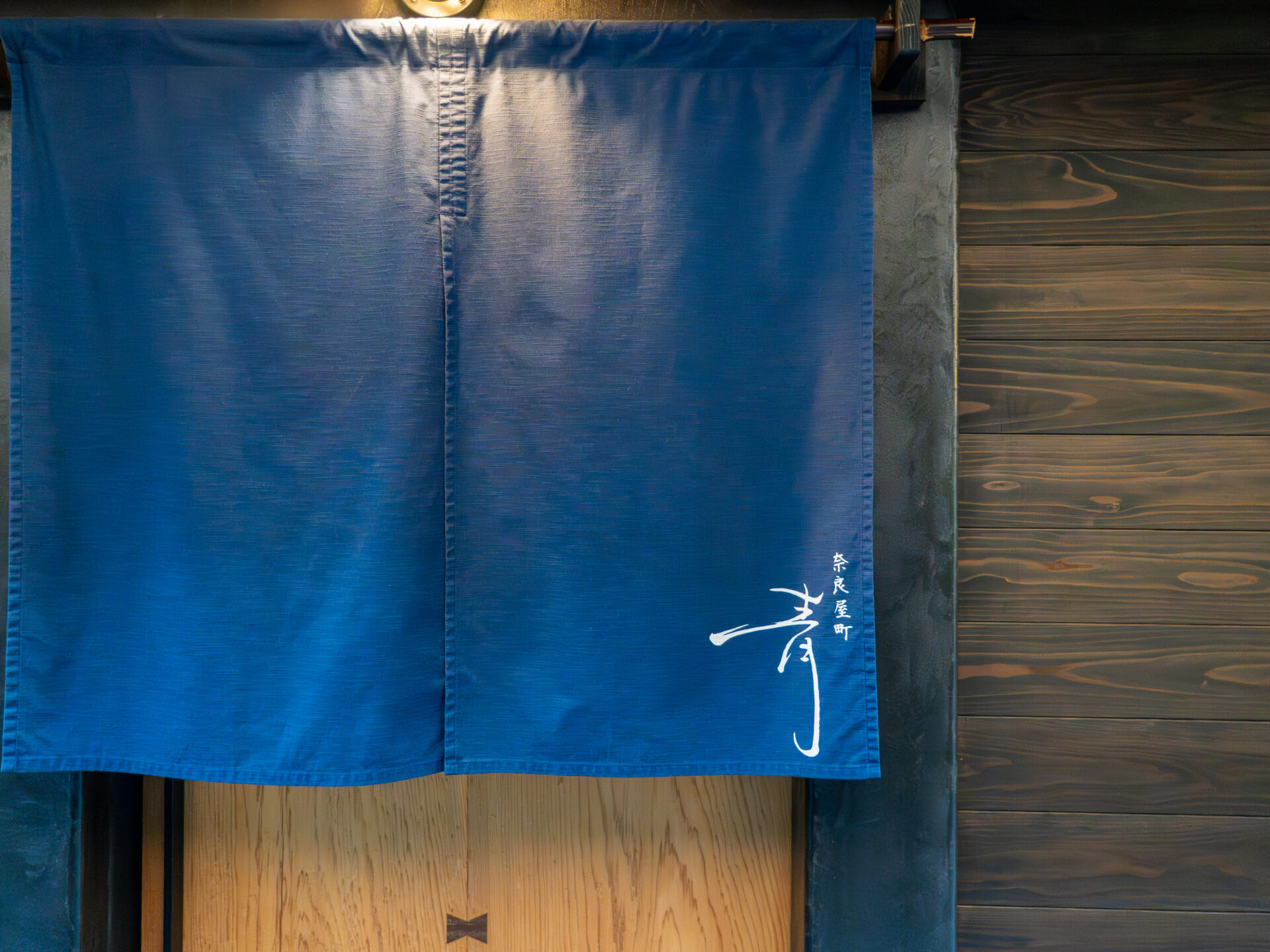
About Chef Hideyuki Kaneda – A Cook Who Journeys Through Sensibility and Technique
Born in 1980 in Shimonoseki, Yamaguchi Prefecture, Chef Kaneda initially pursued a career in sound engineering after university. But eventually, he found himself drawn to culinary expression and changed paths.
His training began at Maison de Yoshida, a French restaurant in Fukuoka, where he built a foundational understanding over three years. He then spent four and a half years at Kitano Hotel in Kobe, immersing himself in the classical techniques of French cuisine.
Rather than follow a conventional path, Kaneda chose to explore the world through the lens of food—traveling across Asia, Europe, and the Middle East. A pivotal experience came during his time at Gaggan in Bangkok, an innovative restaurant that redefined his perception of culinary frameworks.
Upon returning to Japan, he spent five years at the prestigious Ryugin in Tokyo, refining his grasp of Japanese culinary precision—mastering techniques in dashi, knife work, and heat. Though seemingly distinct from French cuisine, he came to view these traditions as different dialects of the same universal language of cooking.
In 2019, he opened Ao in Narayamachi, Fukuoka. There, memories of his travels, the techniques of East and West, and his quiet but compelling compositional skills come together on the plate—never overexplained, yet always grounded in clarity and conviction.
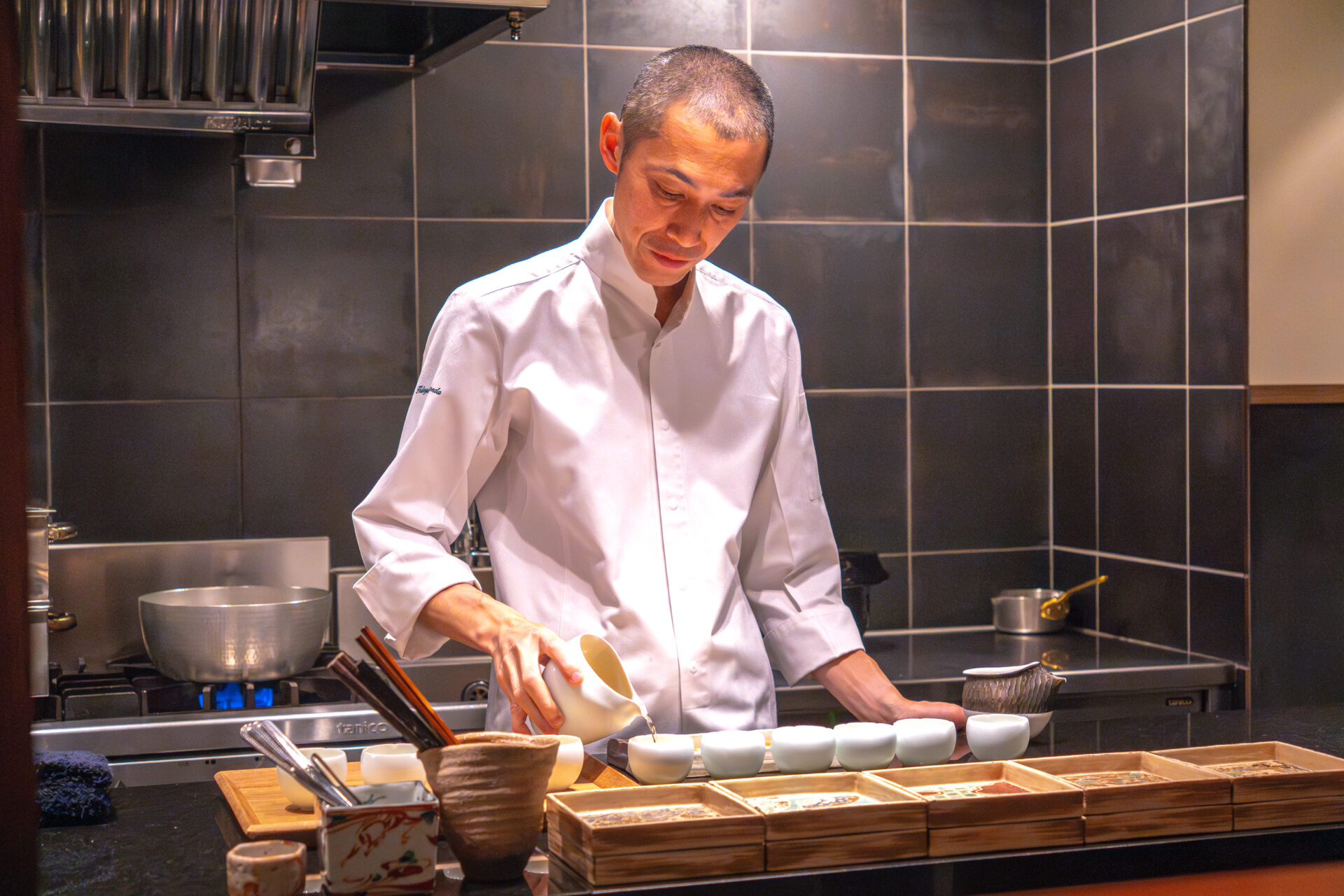
Restaurant Recognition
Since opening, Ao has steadily gained acclaim, with recognition from major guides and awards.
The restaurant has earned a Bronze in the Tabelog Awards for three consecutive years starting in 2022, culminating in a Silver in 2025—a testament to both the chef’s continued growth and the restaurant’s maturation.
It has also been selected for the Tabelog Top 100 Creative & Innovative Restaurants 2025, marking it as a standout that transcends traditional genres.
Further, Ao has been featured in the French restaurant guide Gault & Millau for three years running (2023–2025), receiving a solid 15/20 rating—an acknowledgment of its presence and originality within Kyushu’s innovative dining scene.

Dining Prelude
Exterior & Entrance
Tucked into a narrow alley of Narayamachi, Fukuoka, Ao quietly rests in a remodeled 80-year-old townhouse. The deep black wood facade contrasts with a striking blue noren curtain. A softly glowing lantern lights the path by night, evoking a portal to a different world.
The entrance features an unassuming small window and a discreet sliding door. The minimalist exterior seems to extend the restaurant’s inner stillness outward. A small garden in front hints at nostalgic traces of the Showa era, nestled between city spaces.
The understated exterior builds anticipation—stepping inside reveals a 9-seat counter overlooking a wide open kitchen, offering a preview of the immersive, live experience that awaits.
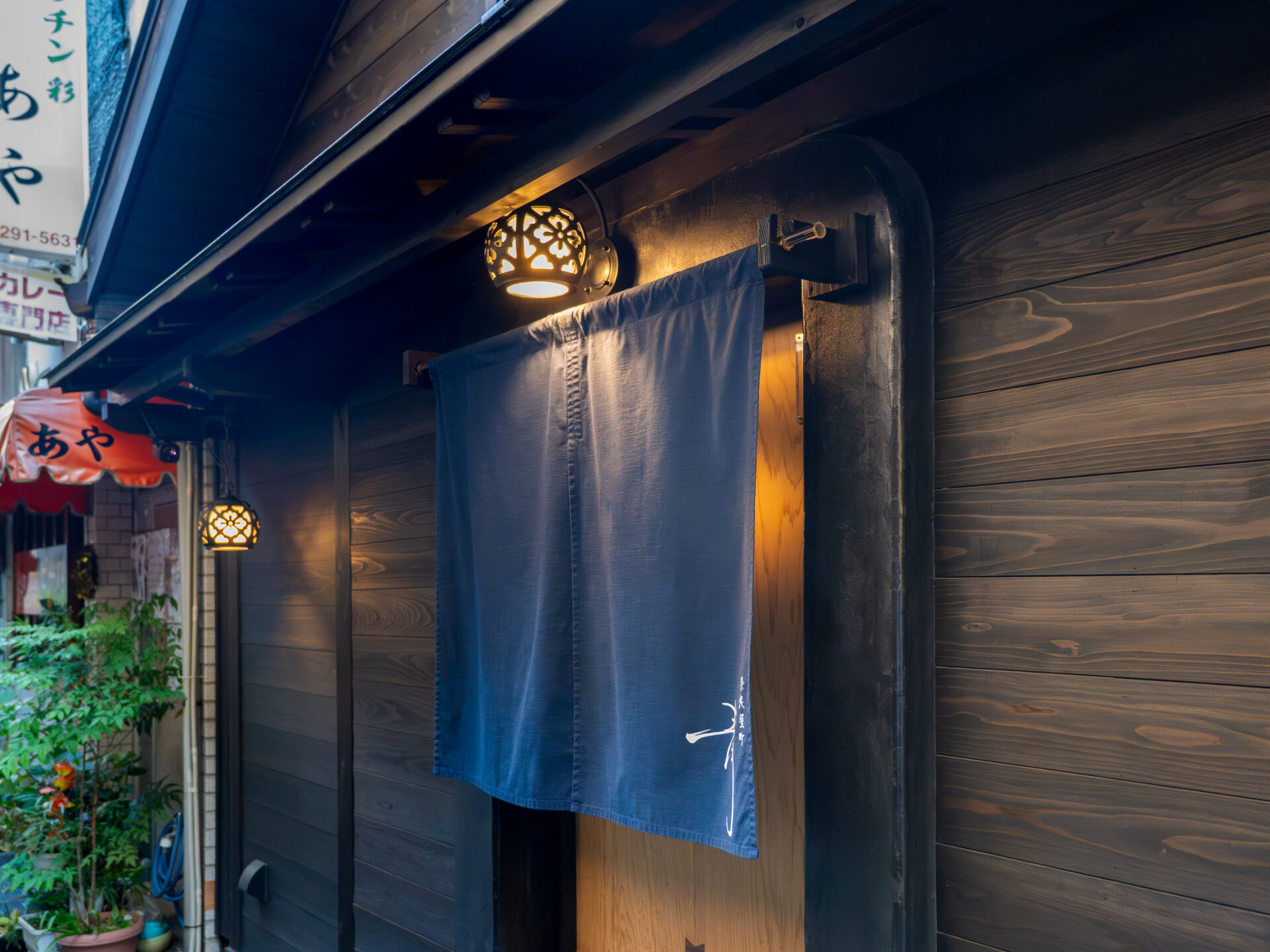
Dining Space
The interior of Ao is crafted from a 70-year-old home, reimagined into a modern L-shaped counter with just nine seats. The wide wooden counter feels warm, yet maintains a slight formality and focus between guest and chef.
From every seat, guests can witness the action in the kitchen—knife work, flickers of flame, the pouring of dashi—all seamlessly integrated into the multisensory experience. The design brings to life a culinary stage where food is performed.
Decor is pared down to the essentials. Subtle lighting ensures the dishes take the spotlight. The simple yet elegant space feels like the prologue to a story, imbuing a quiet tension that gently straightens your posture each time you visit.
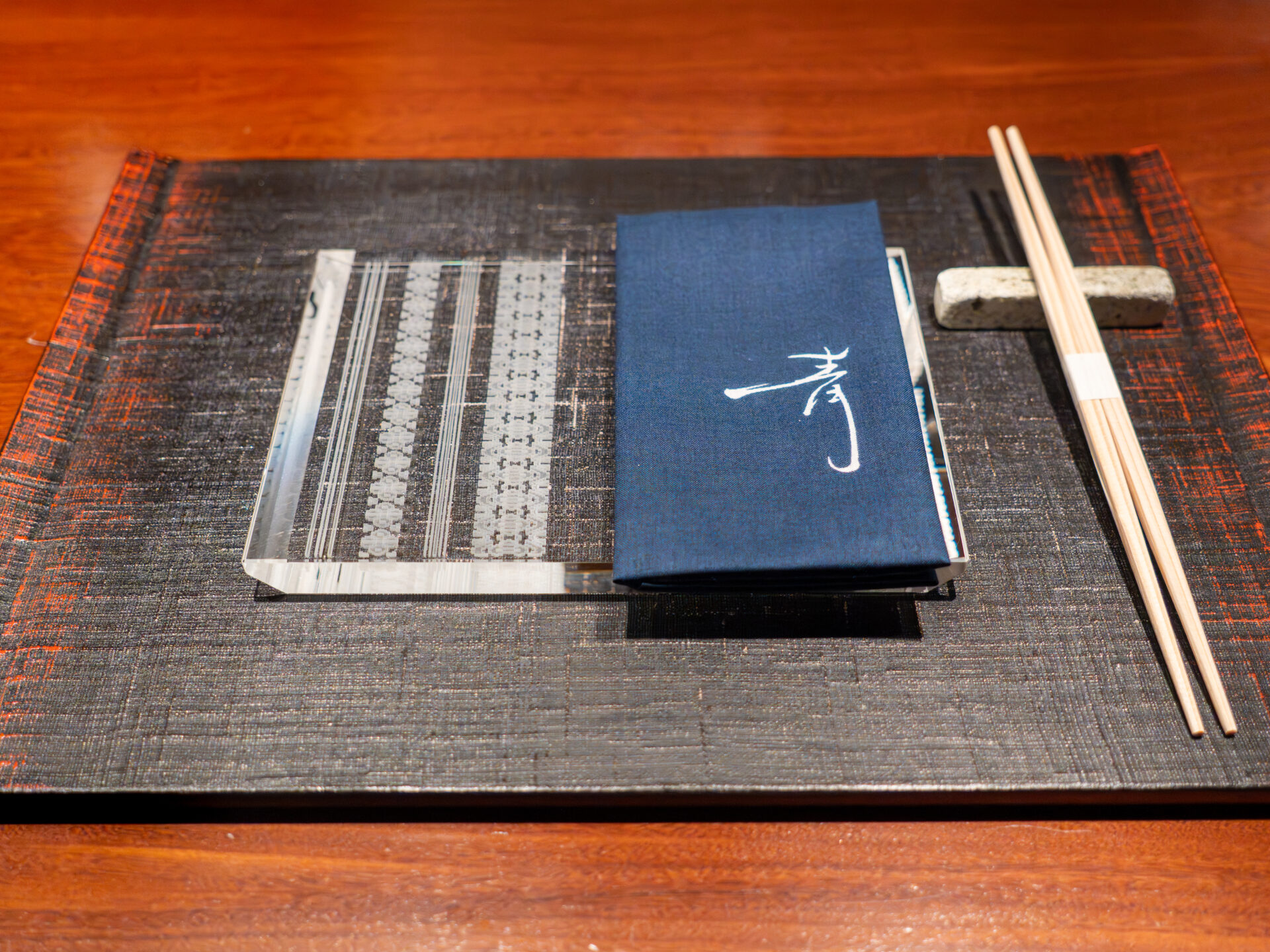
Menu Presentation
Ao’s cuisine is free from conventional constraints, yet driven by a clear throughline.
While based on French technique, its treatment of ingredients and flavor development is deeply Japanese.
The scent of dashi, the timing of the flame, the rhythm of the knife—every detail is already “cooking” before it appears on the plate.
The course consists of about 15 dishes, omakase only—no adjustments made per guest. Instead, each dish unfolds the unique aromas and temperatures of the present season with meticulous care.
Ingredients are sourced from all across Kyushu, featuring vegetables and seafood traceable to individual producers. Local specialties like konoko (sea cucumber ovaries), horse meat, and Takezaki crab may make appearances, reflecting regional character.
There is no flashy performance, but subtle acts—wrapping, breaking, melting—invite the diner’s participation. These tactile moments gently draw you deeper into the experience.
The course has a deliberate rhythm—flavors and scents rise and fall like breath.
The phrase “eat with all five senses” feels insufficient. Here, you taste with your entire being.
Starter Drink & Pairing
The meal opens with:
José Michel “Premice” Extra Brut,
a Champagne based on Pinot Meunier, offering aromas of white fruit and freshly baked bread. Its extremely dry profile leaves a delicate and lingering finish.
Ao offers thoughtful pairings as well—ranging from sake to natural wines—without being constrained by category. Rather than dramatic pairings, each drink gently complements the dish’s lingering notes.
Every glass embodies a quiet conviction and grace—serving not as a statement, but as a seamless extension of the course.
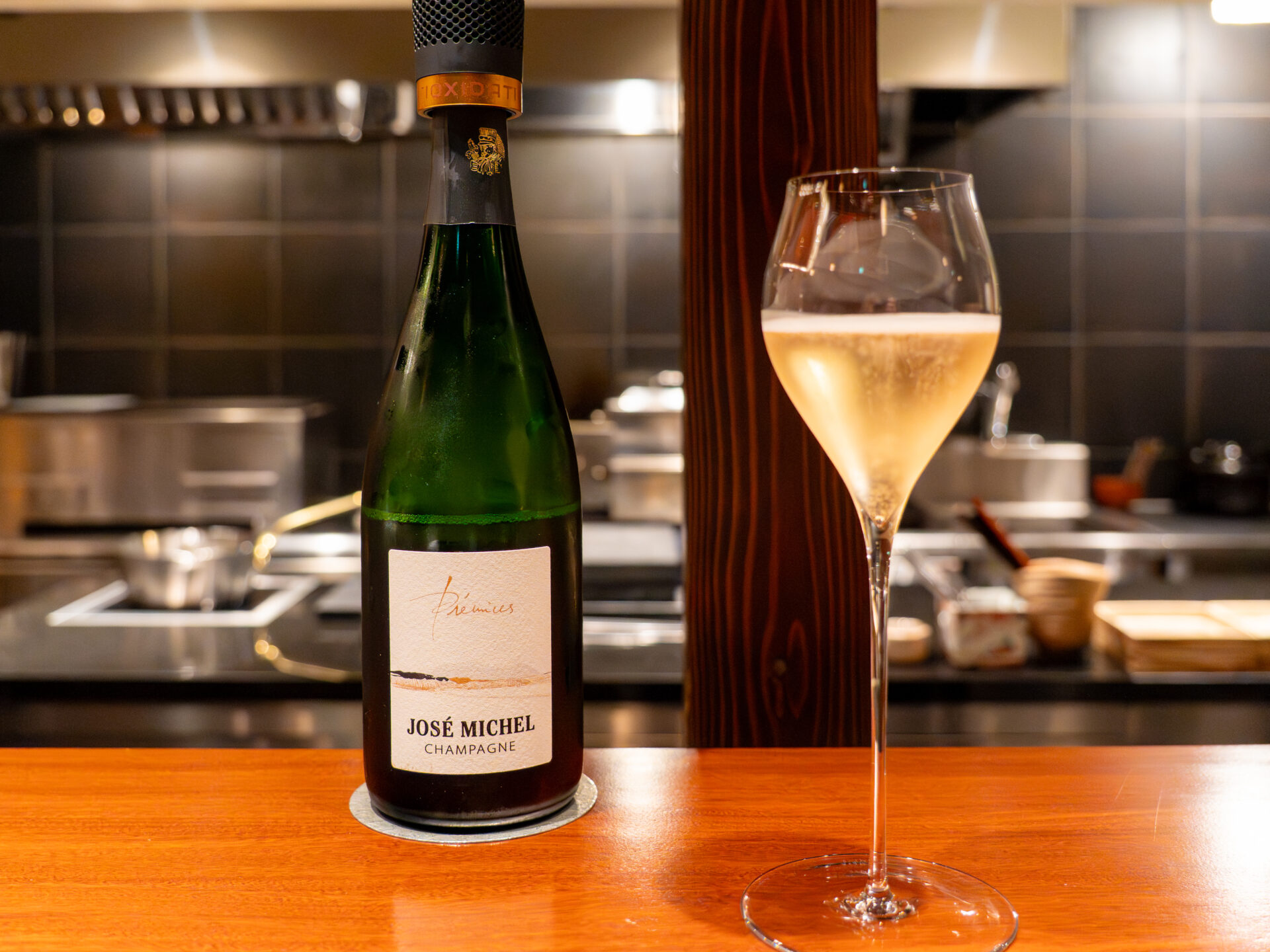
Dishes Personally Experienced
The Black Manjū
The meal opened with a signature dish.
A warm black steamed bun (manjū) filled with a rich mixture of foie gras, pork trotter, and truffle.
The moment it touches your palate, it bursts with deep umami—an opening act that delivers immediate impact and sets the tone for the course.
Once again, the meal left an imprint—one aligned with the subtle passage of the seasons.
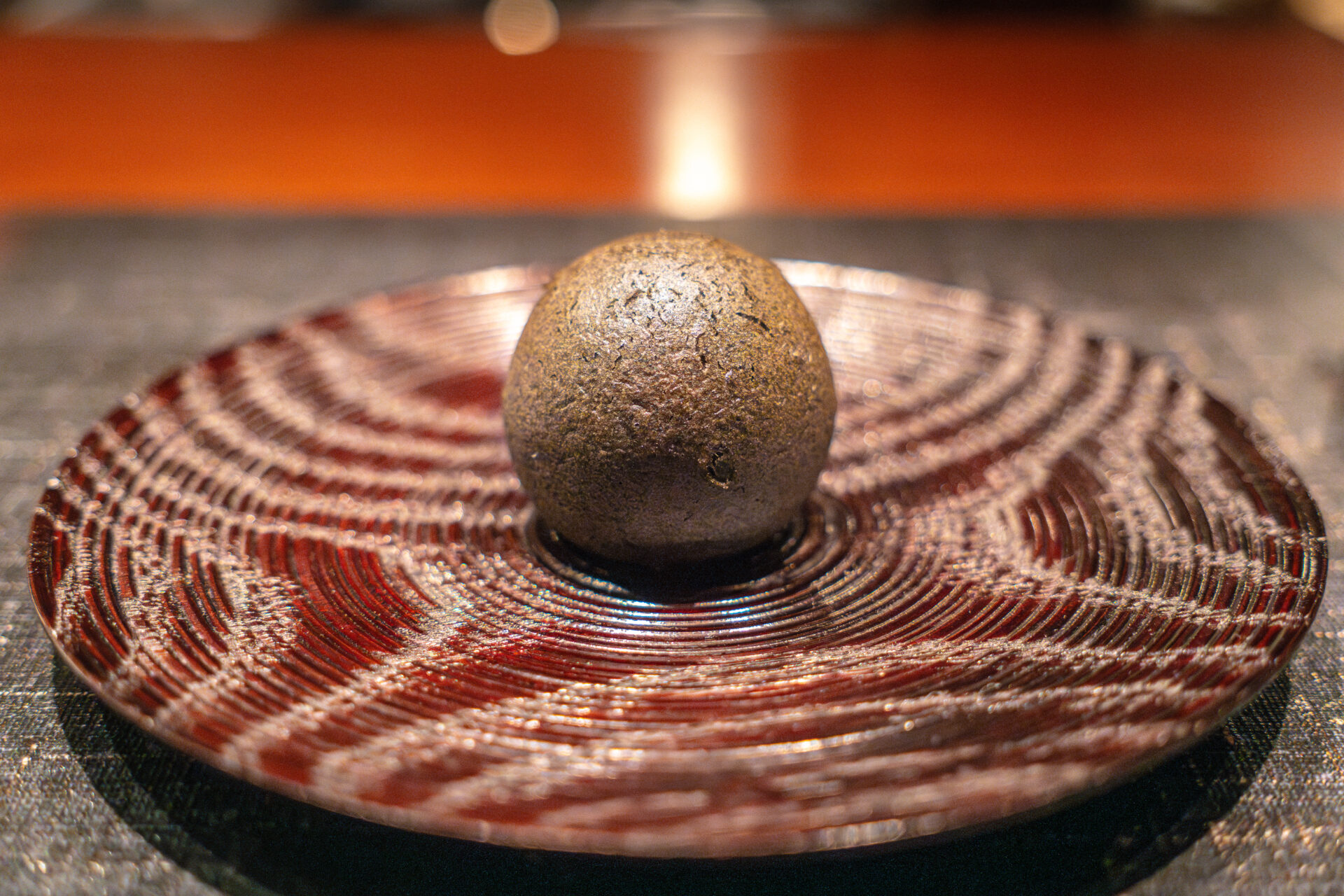
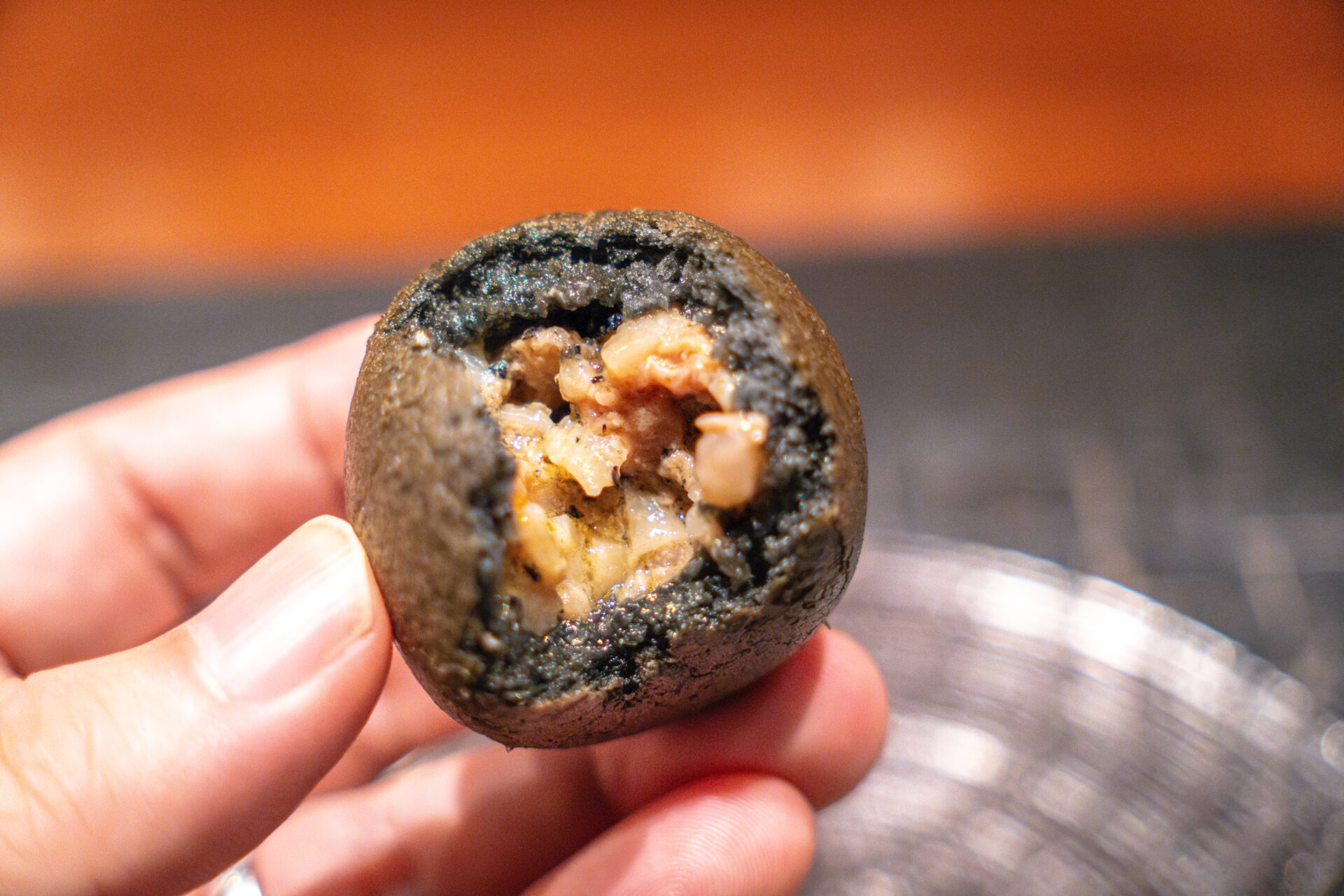
New Ginger Ojiya
The second dish served played the role of oshinogi in traditional Japanese kaiseki—a delicate interlude to bridge flavors.
It was a comforting rice porridge made with fresh ginger.
Its pale hue belied the gently rising aroma.
With a single bite, it soaked into the body like a soft whisper, gracefully connecting the lingering chill of the previous dish with the warmth to come.
The temperature, seasoning, and fragrance—each was restrained, yet flawless.
This was a quiet, precise dish that perfectly prepared both body and mind for what followed.
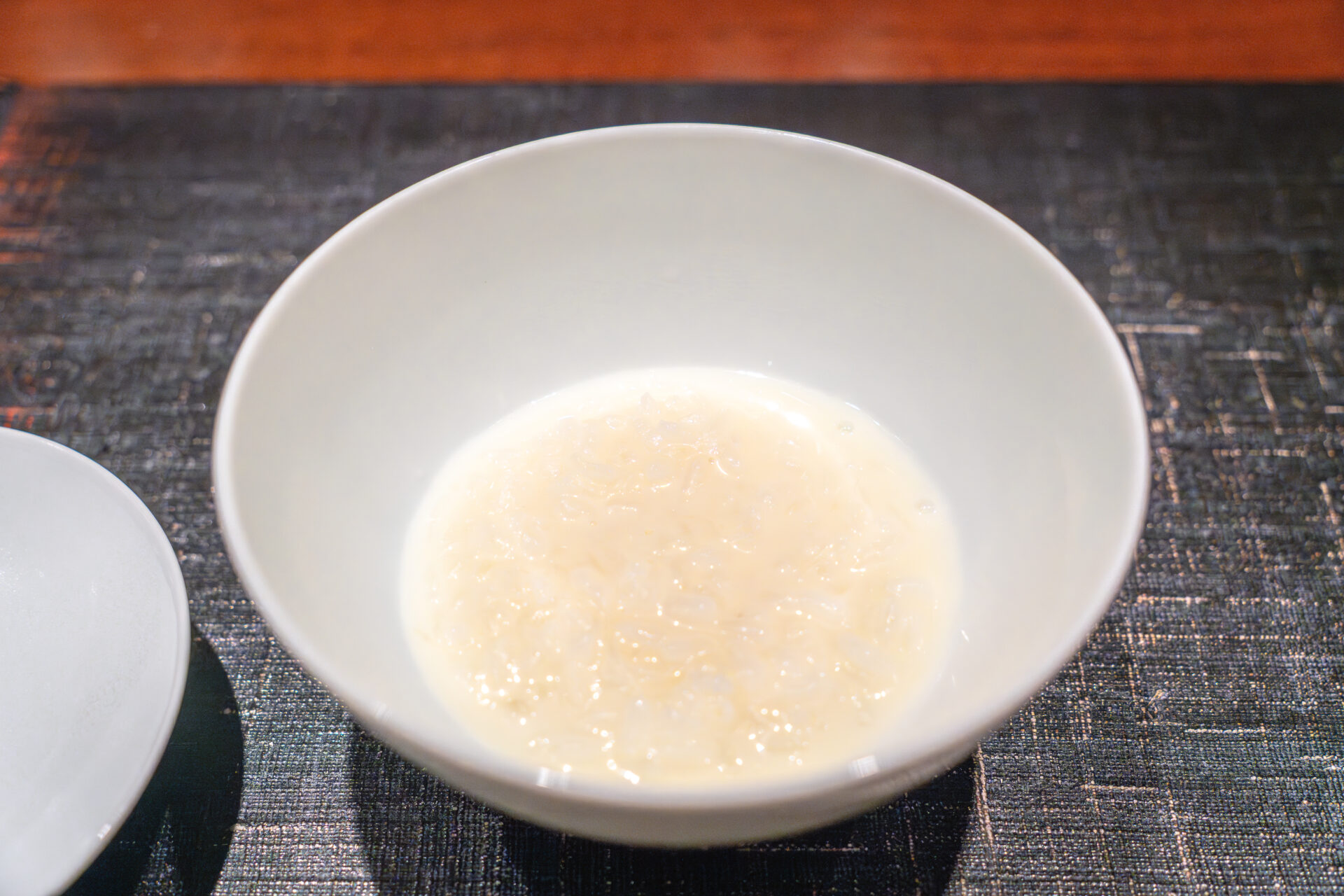
White Asparagus Mousse with Murasaki Uni
At the base lay a mousse made from white asparagus, known for its gentle sweetness.
On top rested purple sea urchin (murasaki uni) from Ōmura Bay and a shimmering gelée made from Ise-ebi (Japanese spiny lobster) consommé.
As the jelly melts into the mousse, it transforms into a cold soup right inside the mouth—where power and subtlety intertwine.
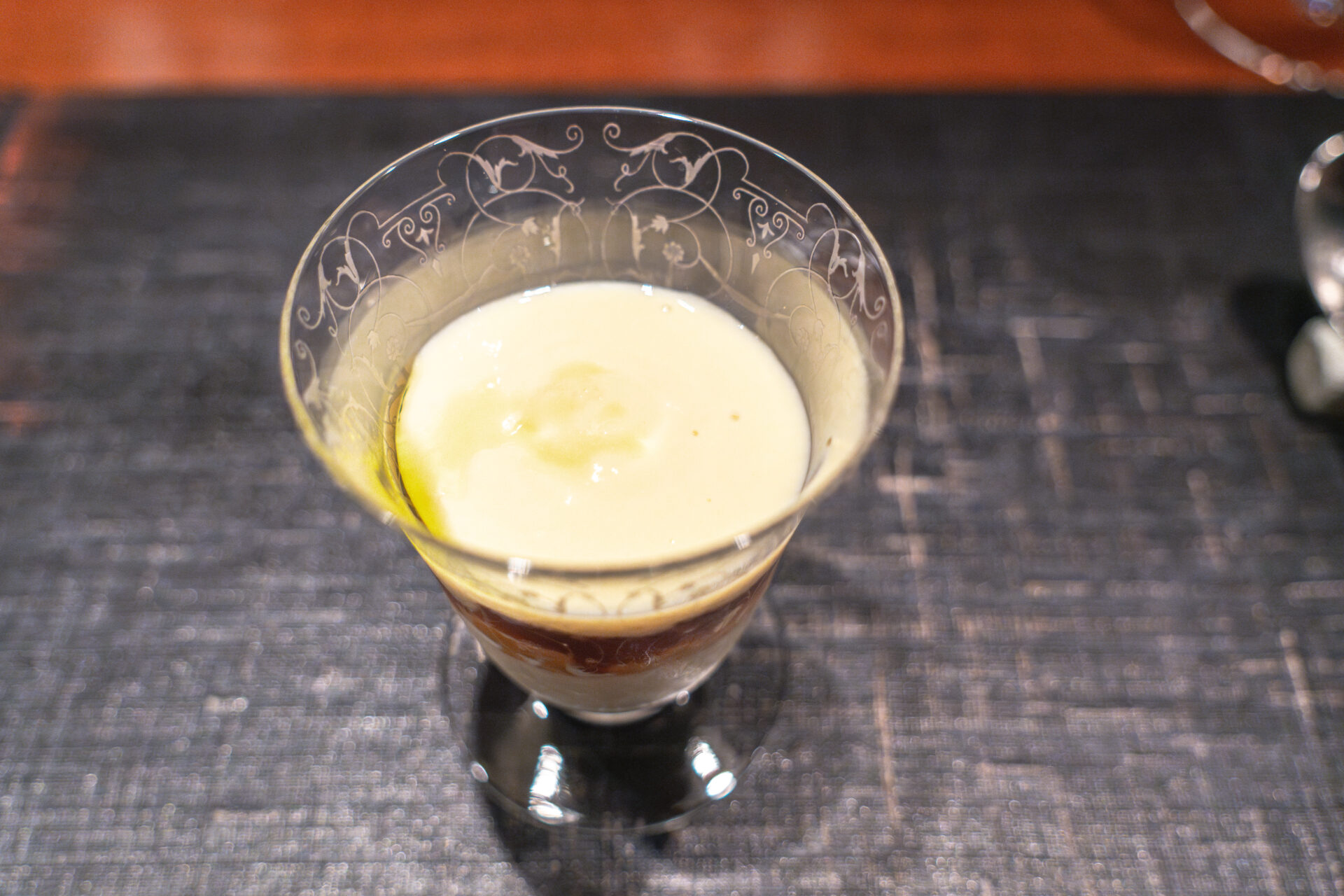
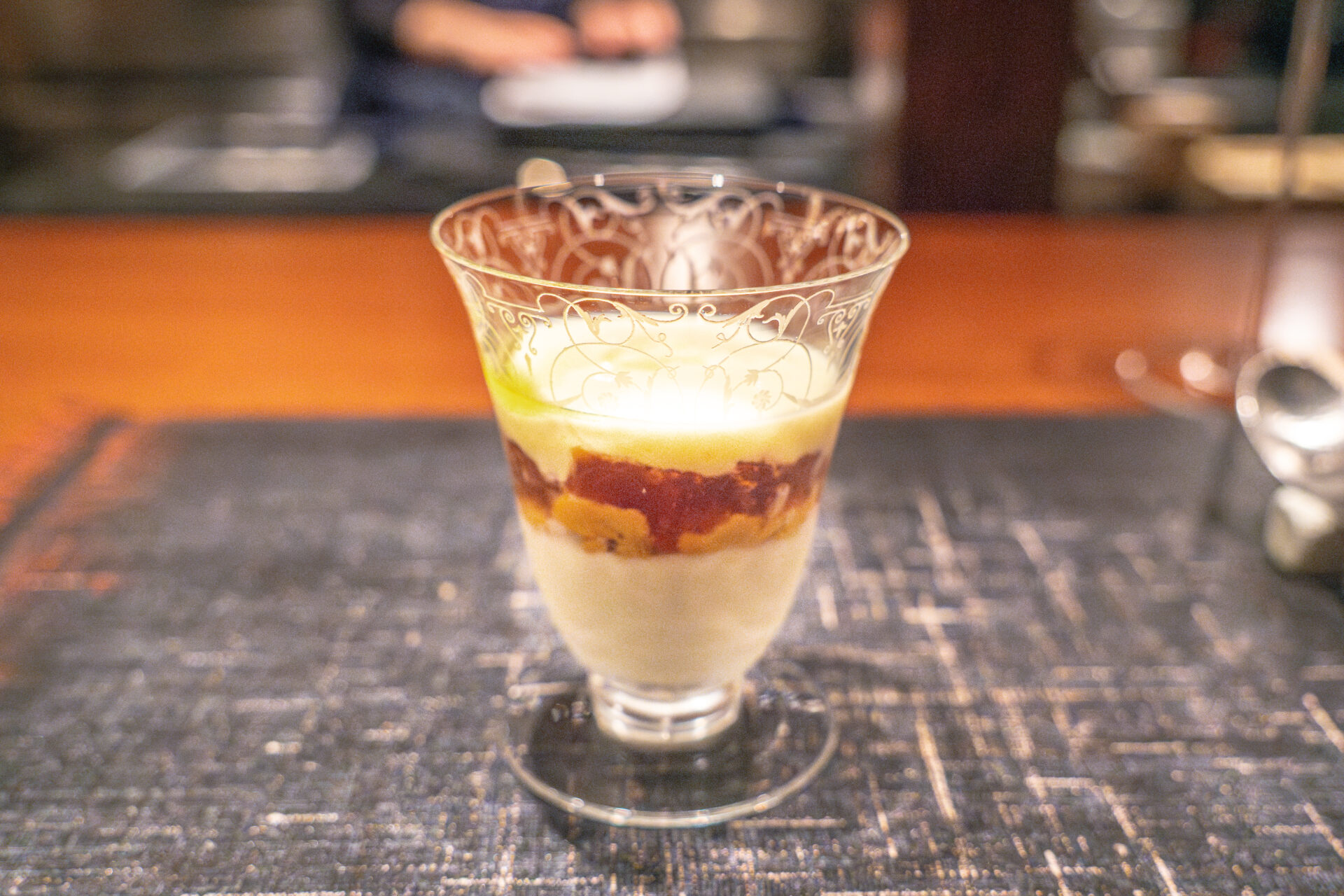
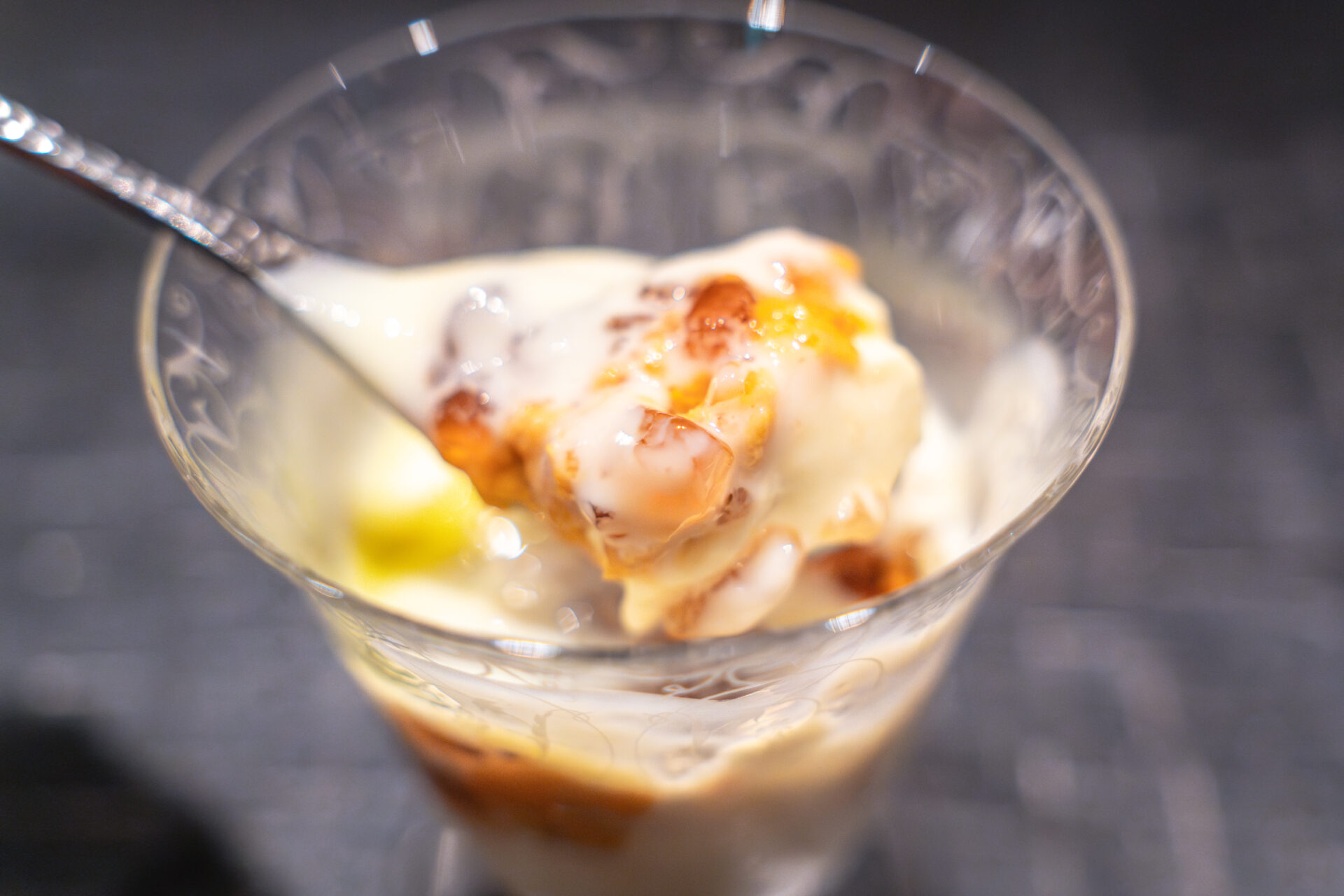
Pairing:
With this dish was served 98WINEs “NOGI”, a wine from Enzan, Yamanashi.
Its soft minerality and depth matched beautifully with the elegant sweetness of the asparagus mousse.
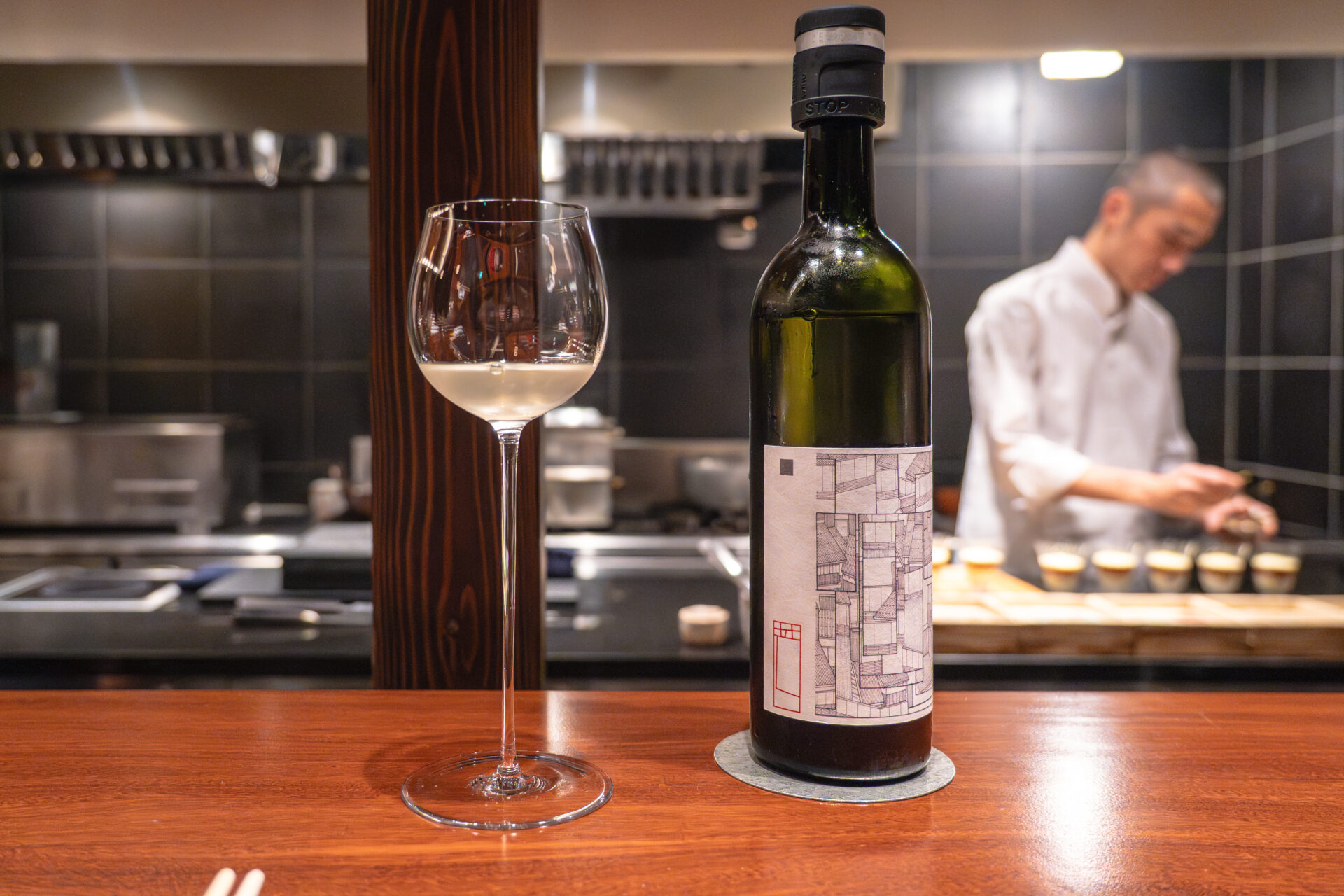
Spring Roll with Hotaru Ika and Bamboo Shoot
A celebration of spring.
The spring roll encased firefly squid (hotaru ika) and bamboo shoot, wrapped in a whisper-thin shell that fried to a crisp, golden finish.
With each bite, the ocean and mountains harmoniously opened up inside the mouth.
The contrast between the gentle texture of the filling and the crackle of the wrapper was exceptional—leaving behind a faint sense of nostalgia and warmth.
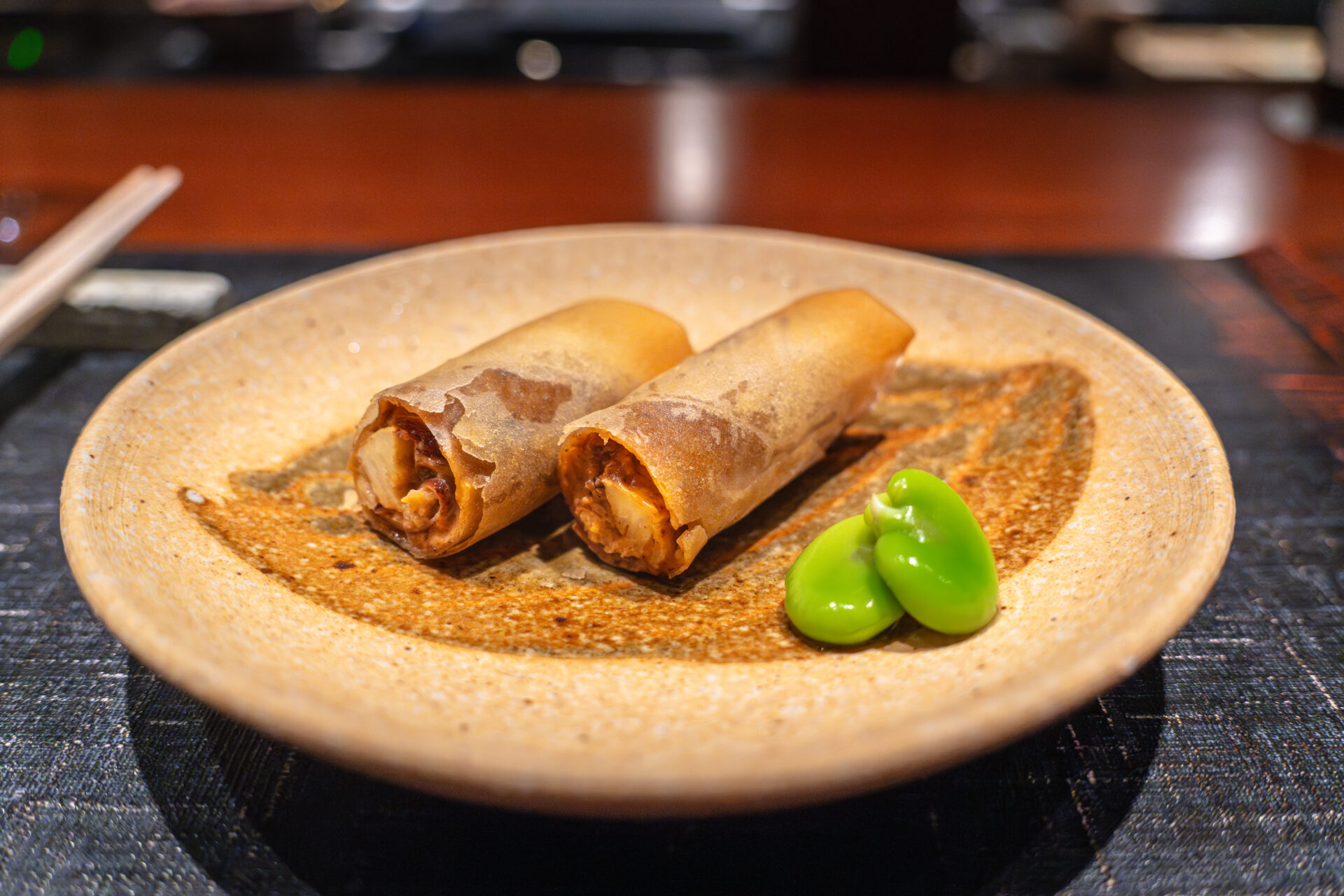
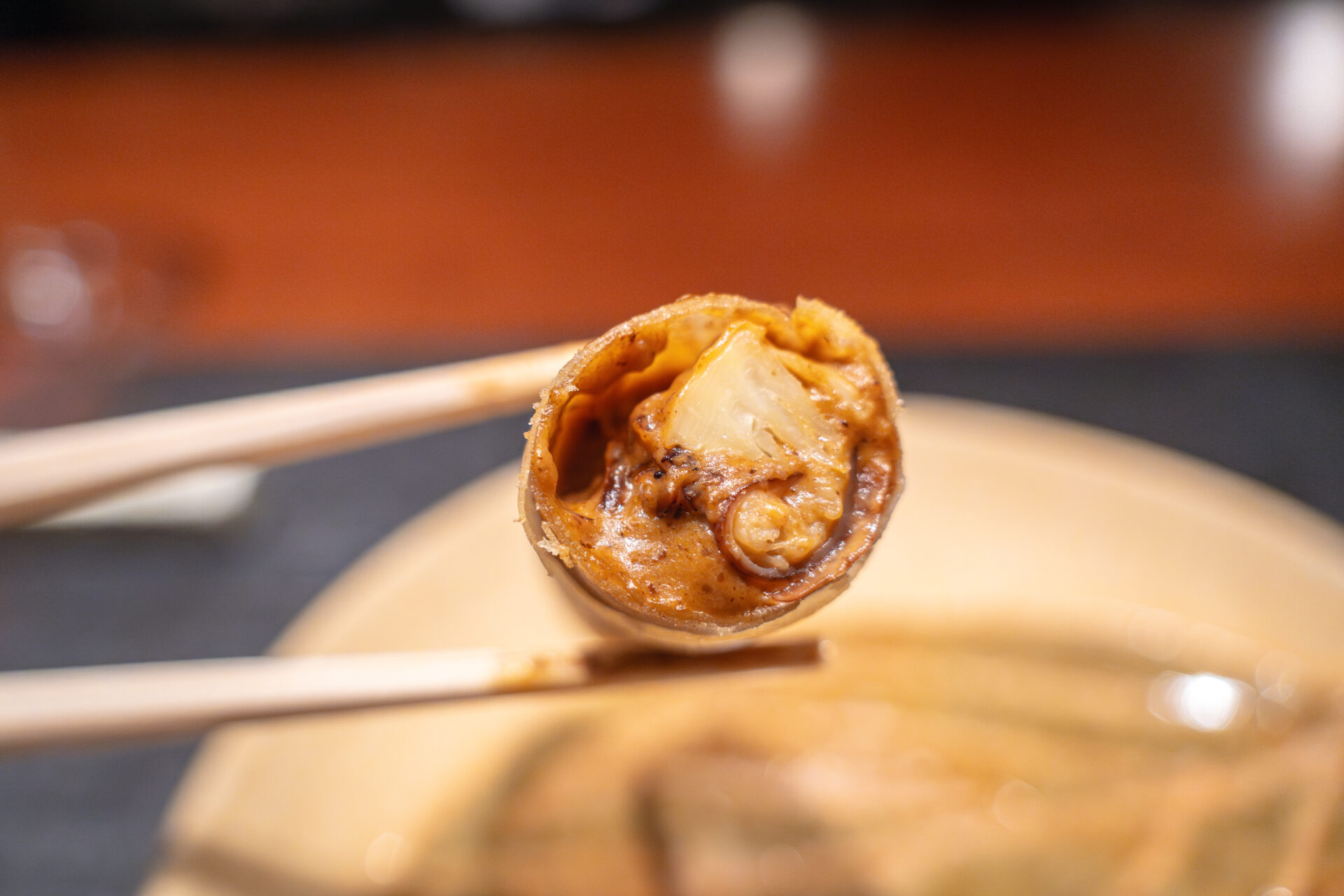
Pairing:
The dish was paired with a Portuguese natural wine, “CEBOLAL”, echoing the earthiness and brininess of the ingredients.
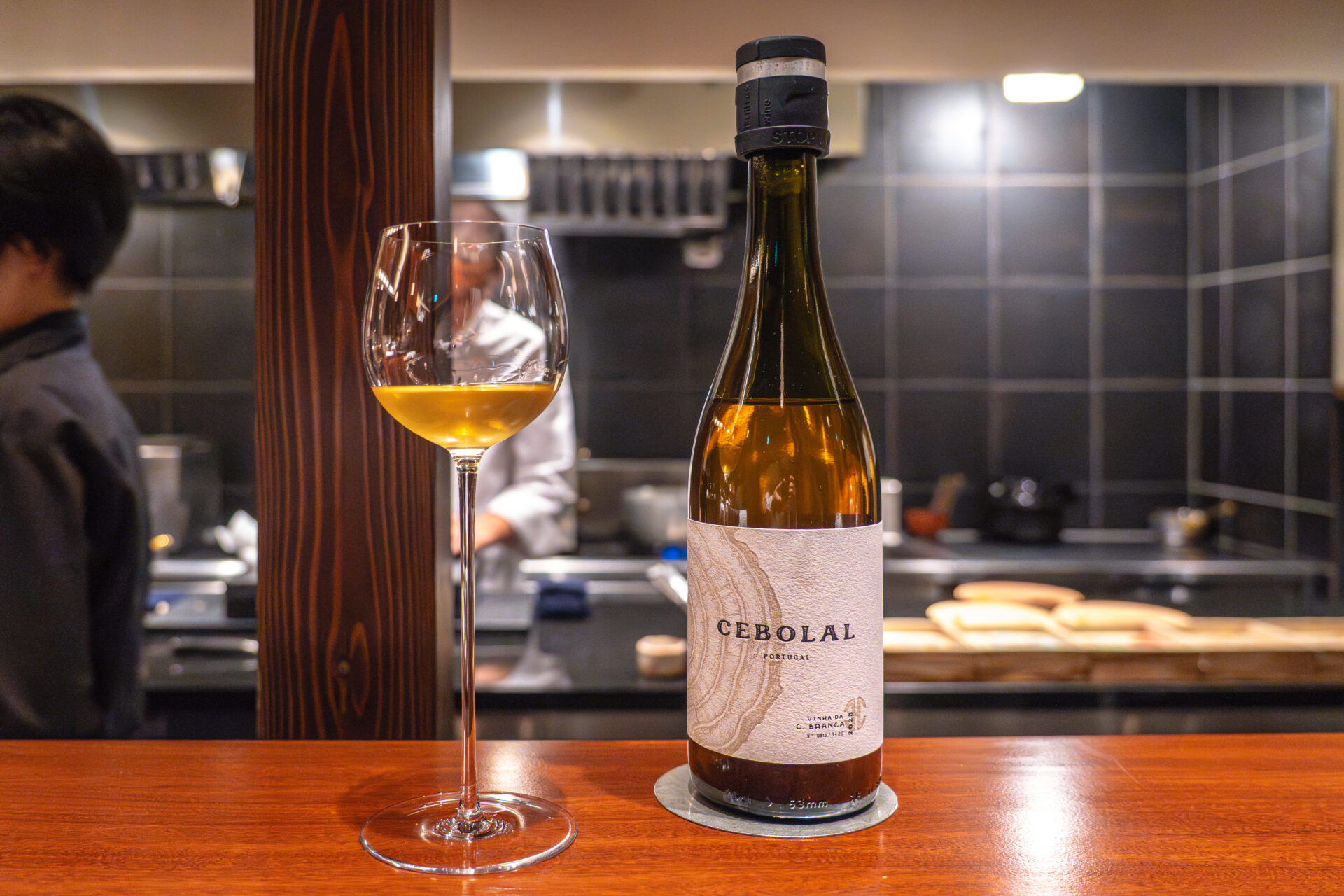
Nagaimo Prepared as Sōmen
Thinly sliced nagaimo (yam), shaved like a katsuramuki scroll and julienned so delicately that it resembled sōmen noodles.
Laid over the top was a striking orange accent: konoko—salt-cured sea cucumber ovaries.
As you gently dissolve the konoko into the yam with chopsticks, the ocean’s umami begins to layer over the clean, crisp flavor of the nagaimo.
A dish of playful presentation and masterful knife work.
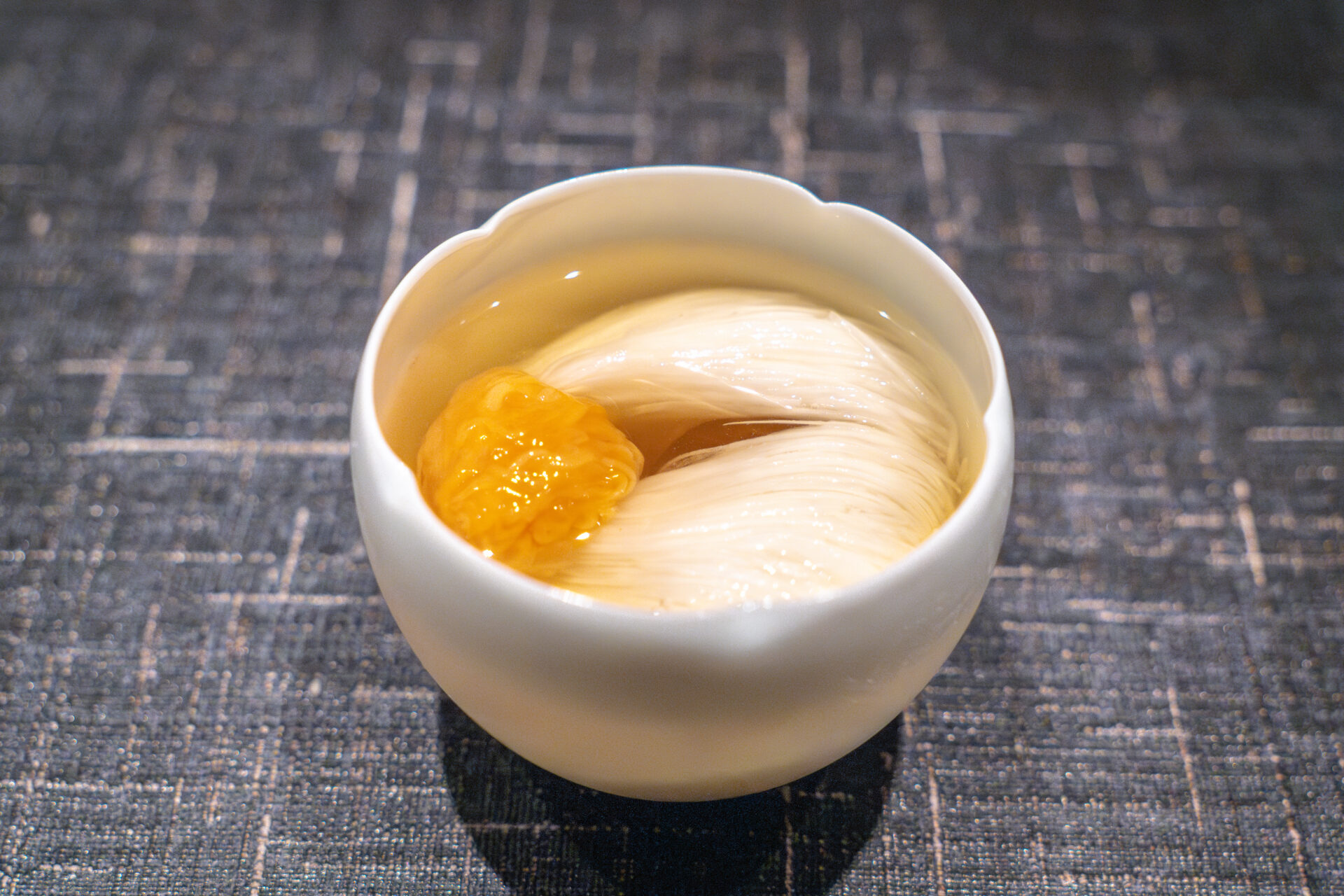
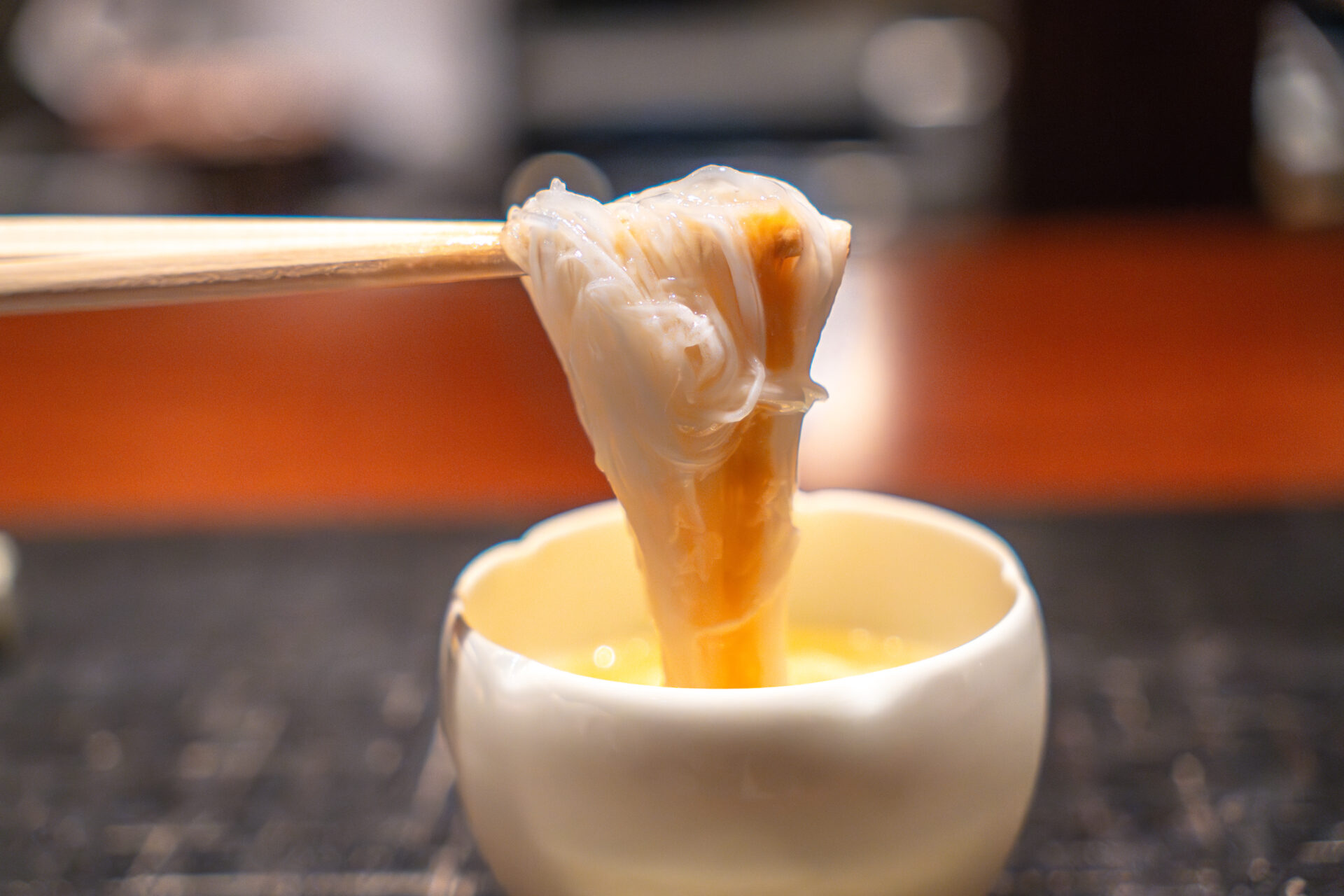
Pairing:
Served with “Nichinichi”, a sake with restrained florality, showcasing the rounded depth of rice and a natural, balanced acidity—echoing the dish’s subtle complexity.
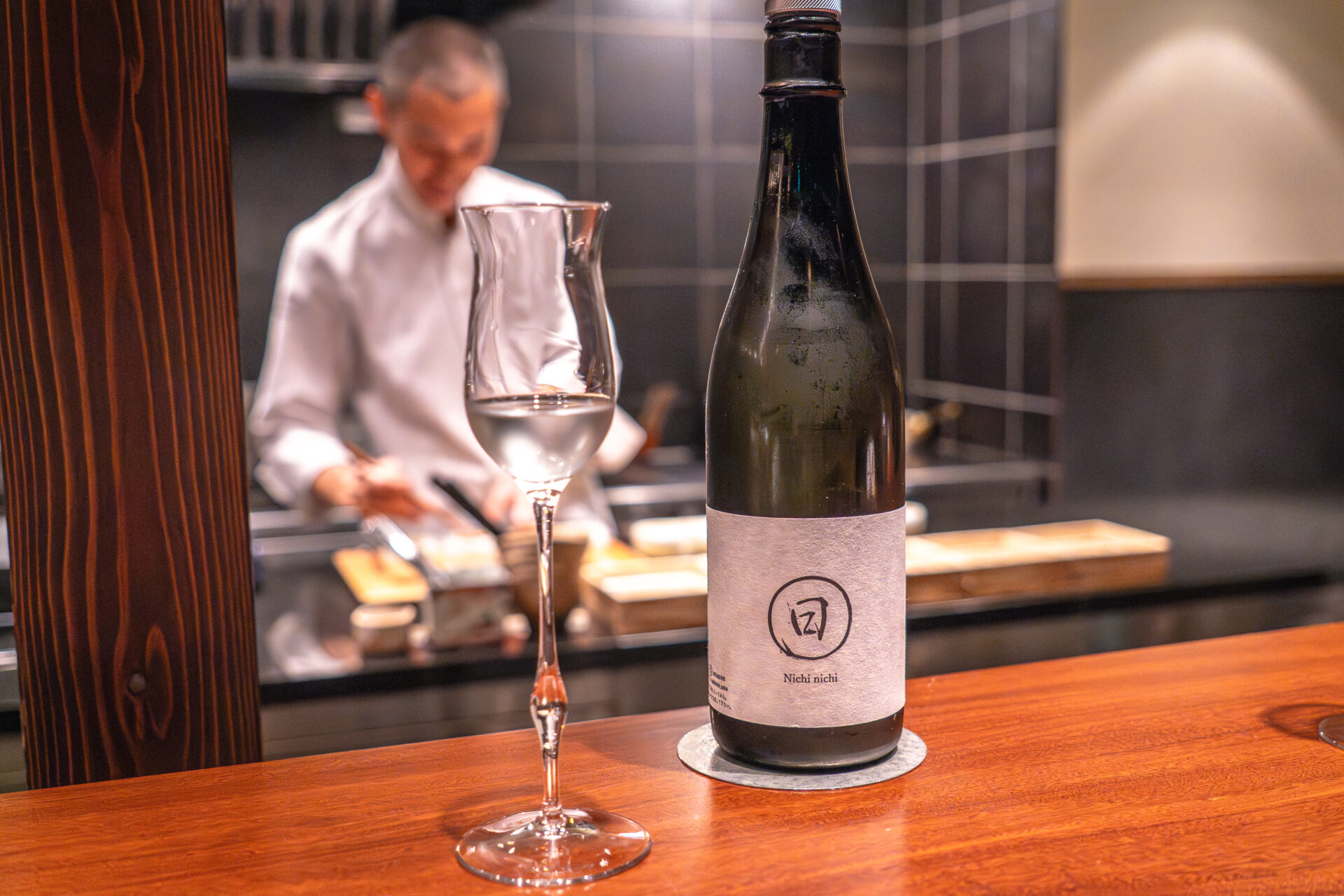
Shabu-shabu of Nozaki Wagyu from Kagoshima
A slice of Nozaki beef sirloin, lightly cooked shabu-shabu style in dashi, drawing out the melt-in-your-mouth fat and deep umami of the meat.
Topped with a nuta (vinegared miso) mixture of wakame and uru-i (mountain greens), this was meant to be wrapped together with the beef and eaten as one.
The warmth, aroma, and harmony of acidity and sweetness made this a beautiful reaffirmation of the elegance of the shabu-shabu technique.
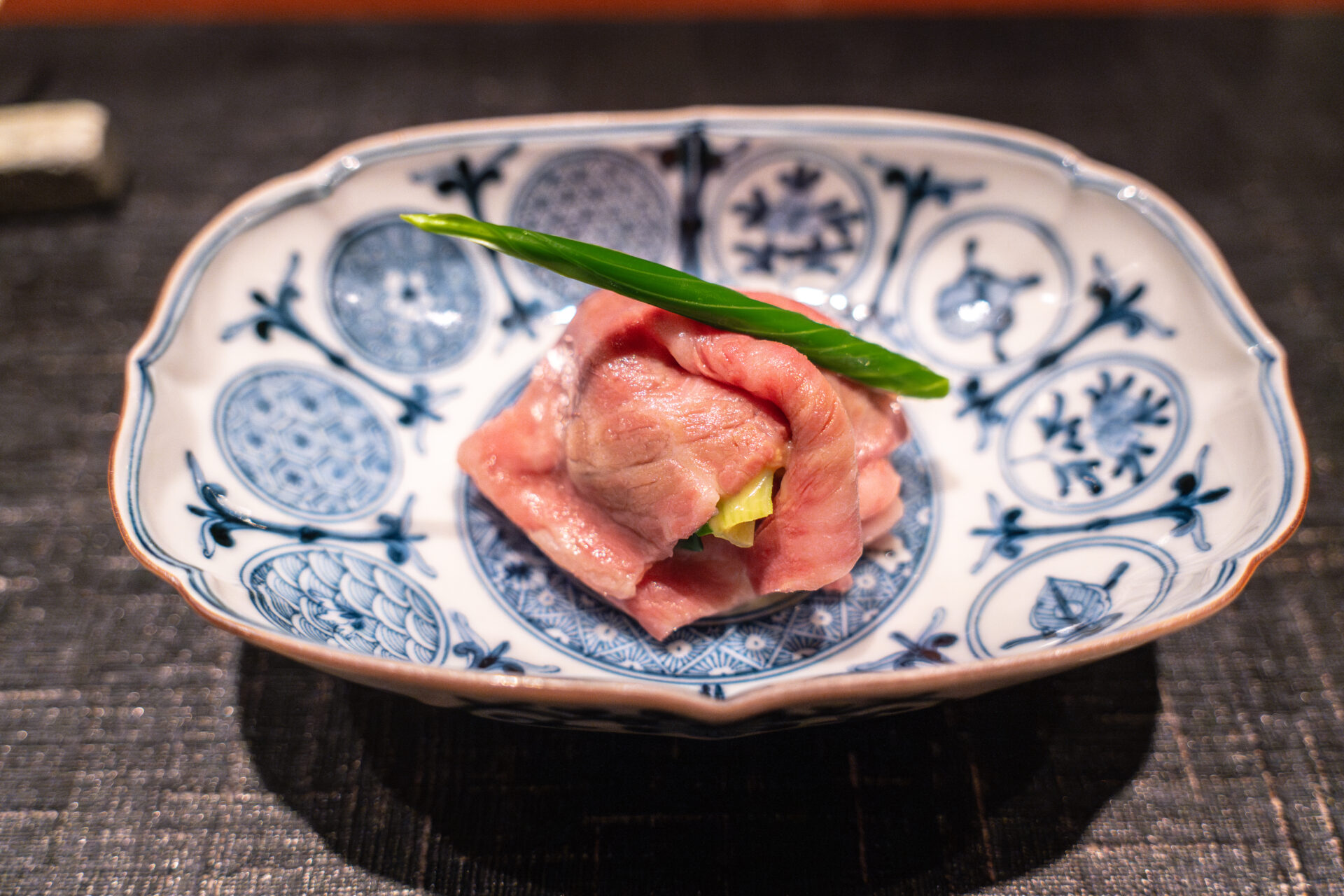
Ao’s Sake Vessels – The First Gesture of “Choice”
Before the first dish is served, a wooden box is quietly placed in front of the guest.
Inside, carefully arranged, are sake cups—glassworks in shades of blue, each one embodying a different expression of “Ao”:
some cool and transparent, others deep and heavy, some reflecting light with brilliance.
These are not mere off-the-shelf vessels, but custom creations by artists who resonate with Chef Kaneda’s vision.
Every curve, weight, and cut is designed in thoughtful harmony with the cuisine and space—objects so refined they make your posture straighten the moment you pick one up.
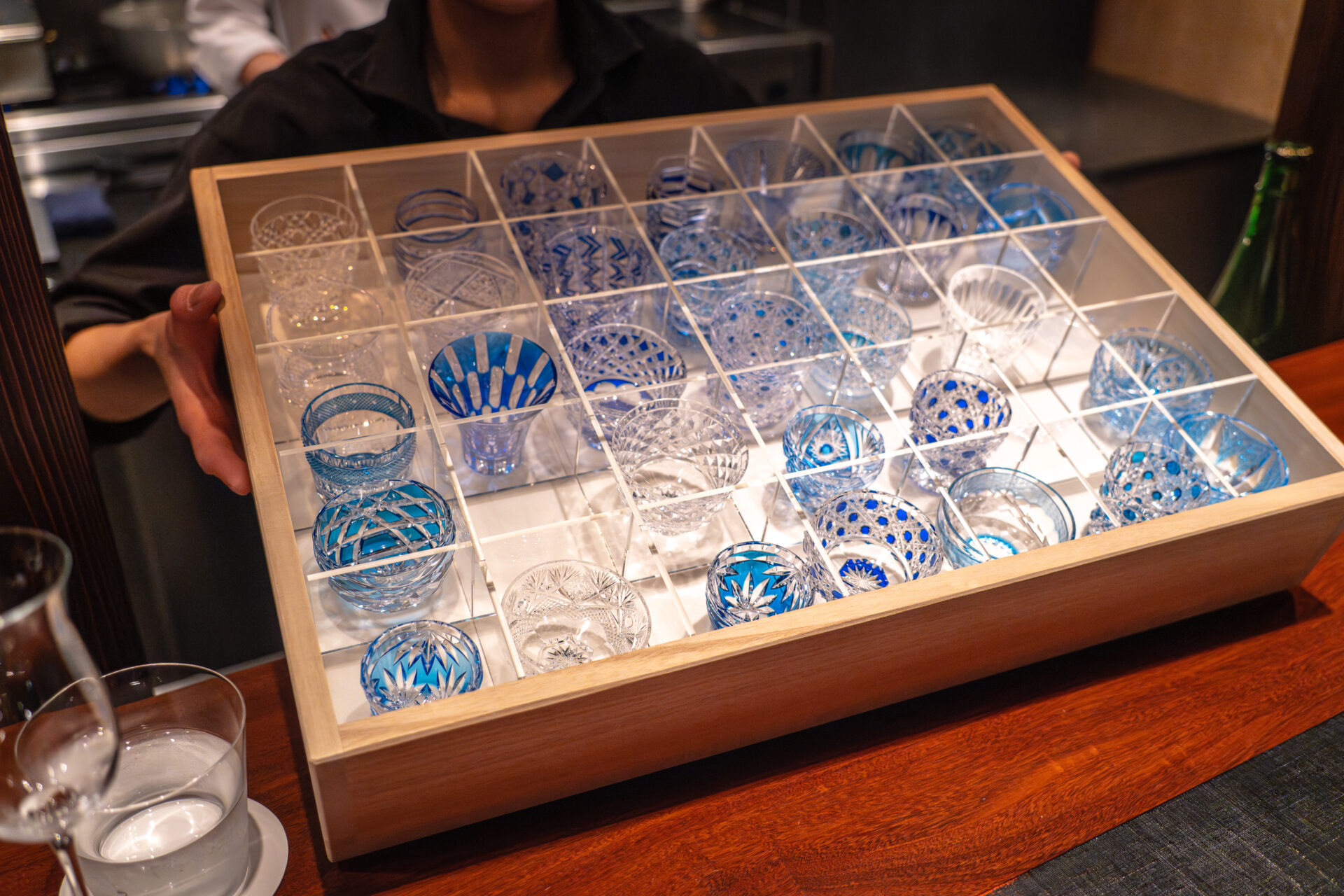
Guests are invited to choose their own glass.
The act of choosing—how you reach for it, how you hold it—this too, at Ao, becomes part of the dining experience.
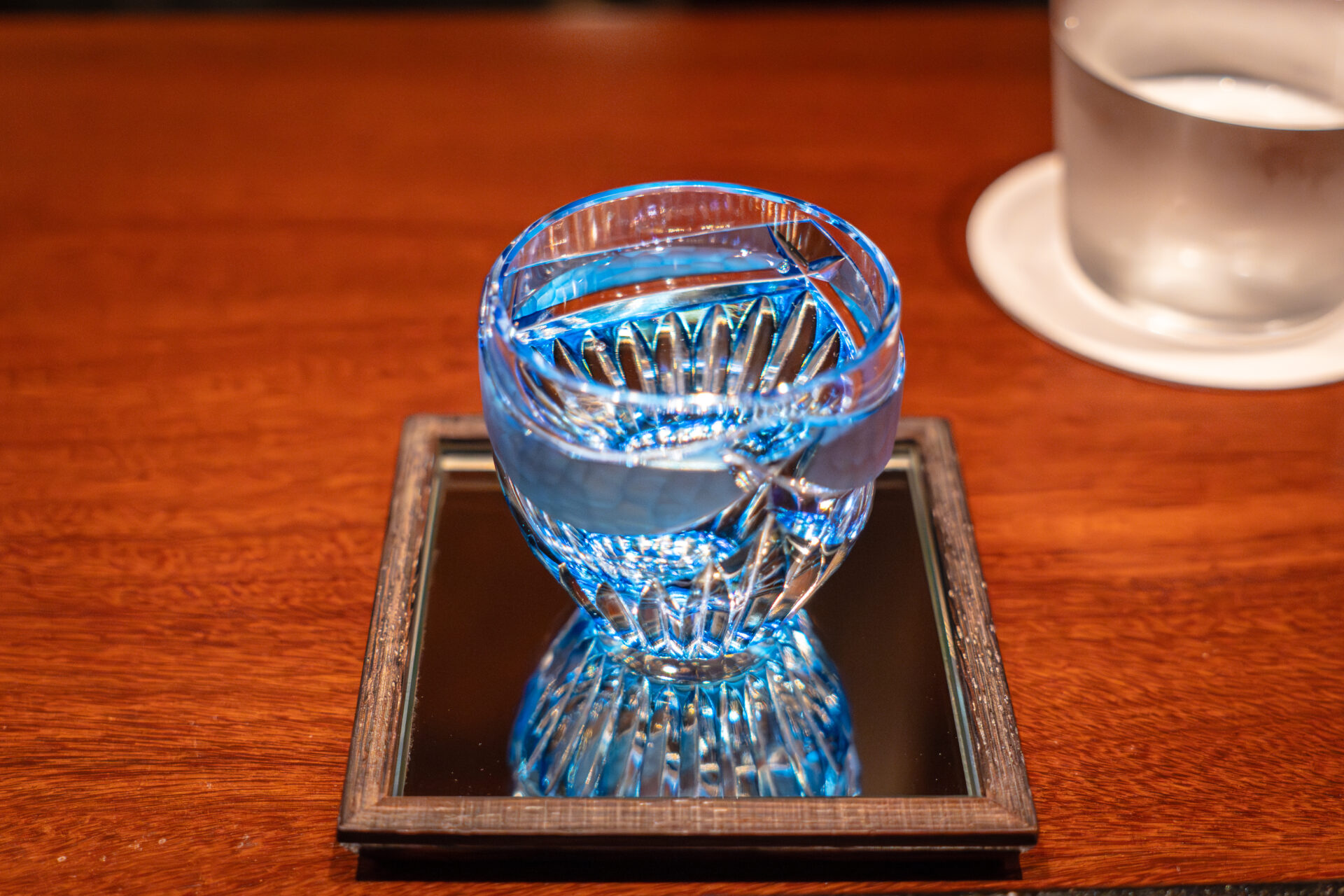
Paired with this selection:
“Gangi No.2” from Yao-Hachishin Shuzo in Yamaguchi.
It offers clean, rice-forward umami and a crisp finish that gently echoes the flavors of the shabu-shabu broth and the acidity of the nuta, tightening the richness of the beef and rounding the dish with finesse.
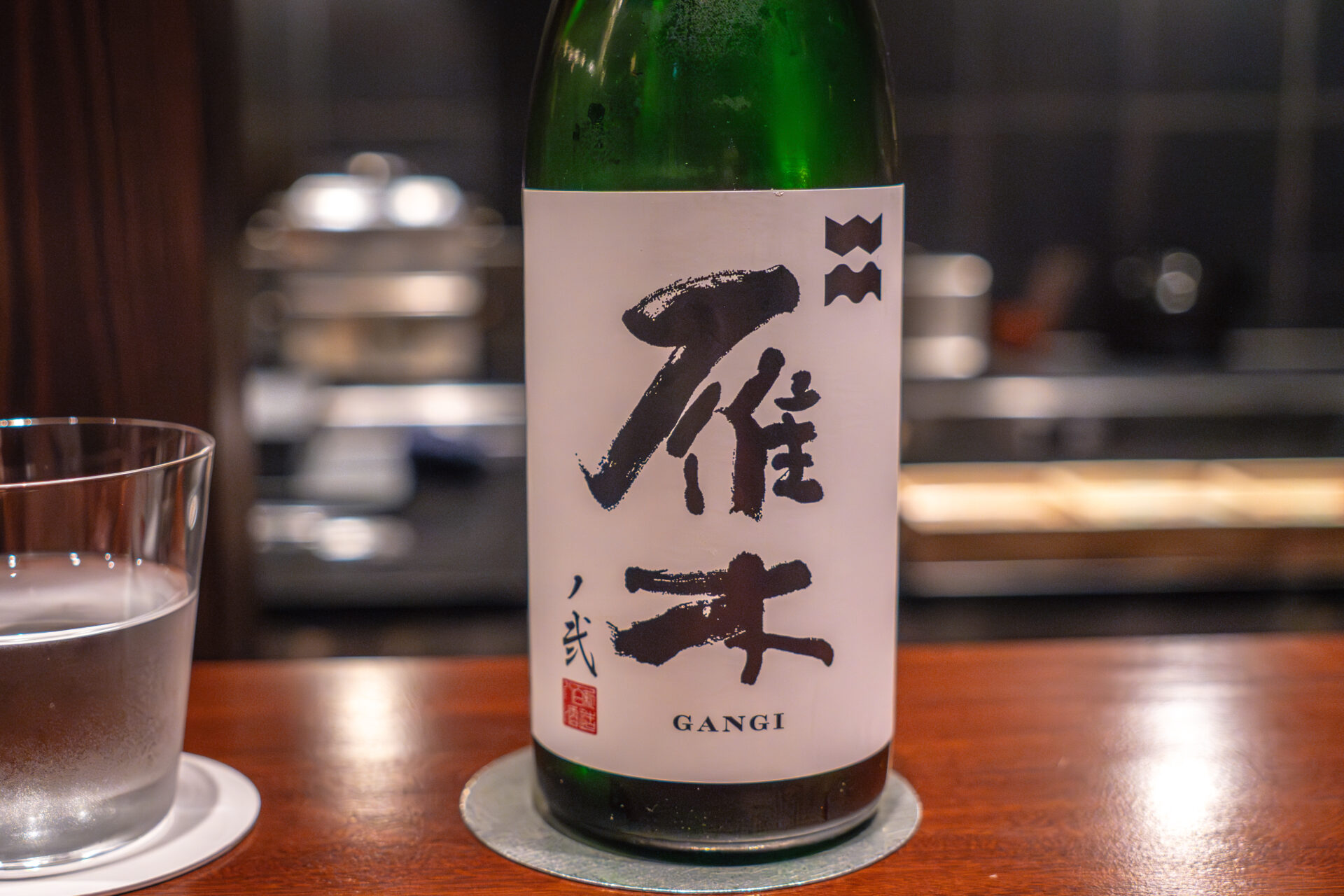
Horse Meat
Horse meat from Kurume was gently smoked using cherry wood chips, giving the lean red meat a fragrant finish and an incredibly tender, moist texture.
Aromatic herbs from Kubota Farm subtly enhanced the lingering flavors.
The dish was served wrapped in a crepe made from rice flour. As you roll and eat it with your hands, aroma, texture, and taste blend together into a harmonious whole.
It was a playful and richly local composition that highlighted the bounty of the region.
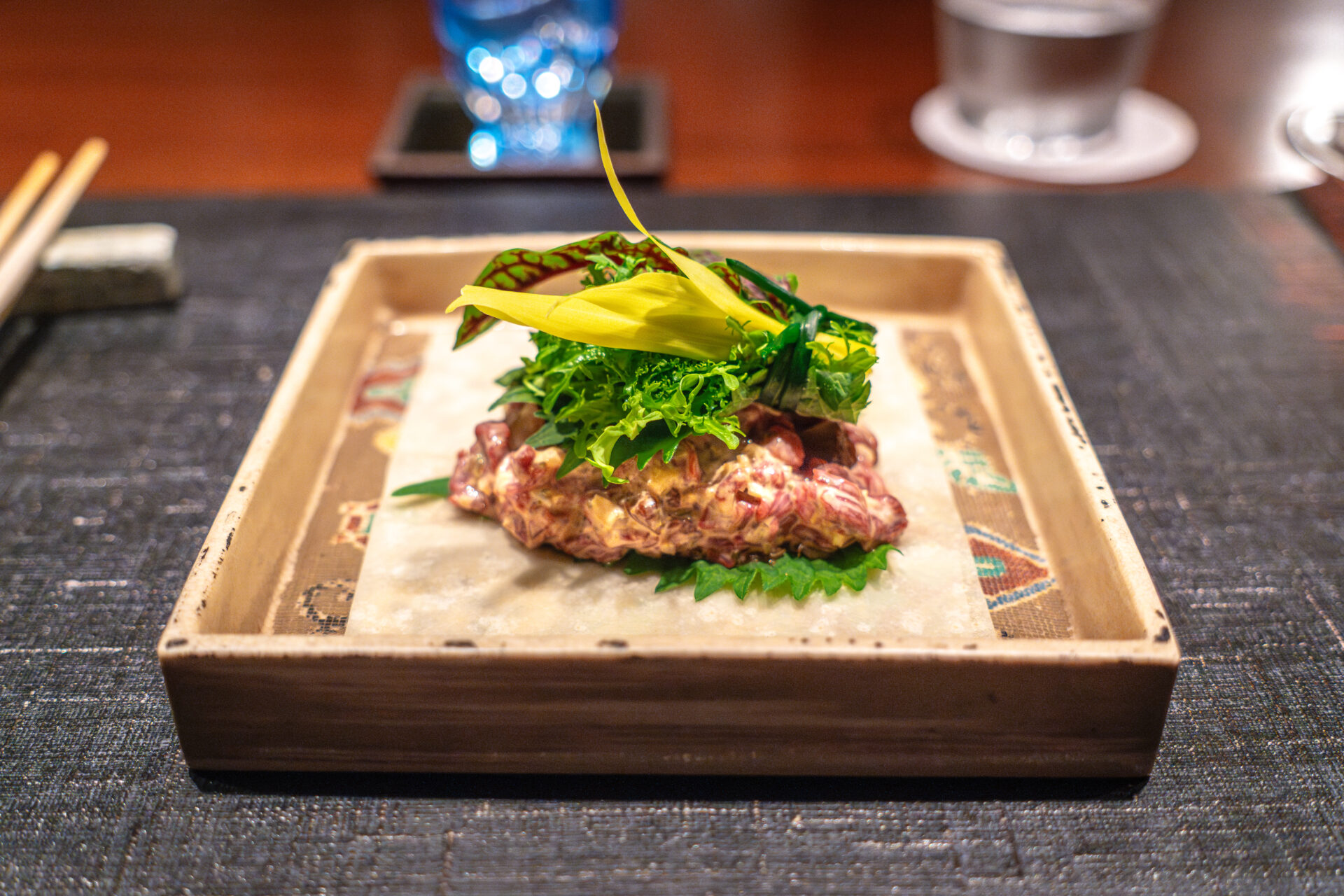
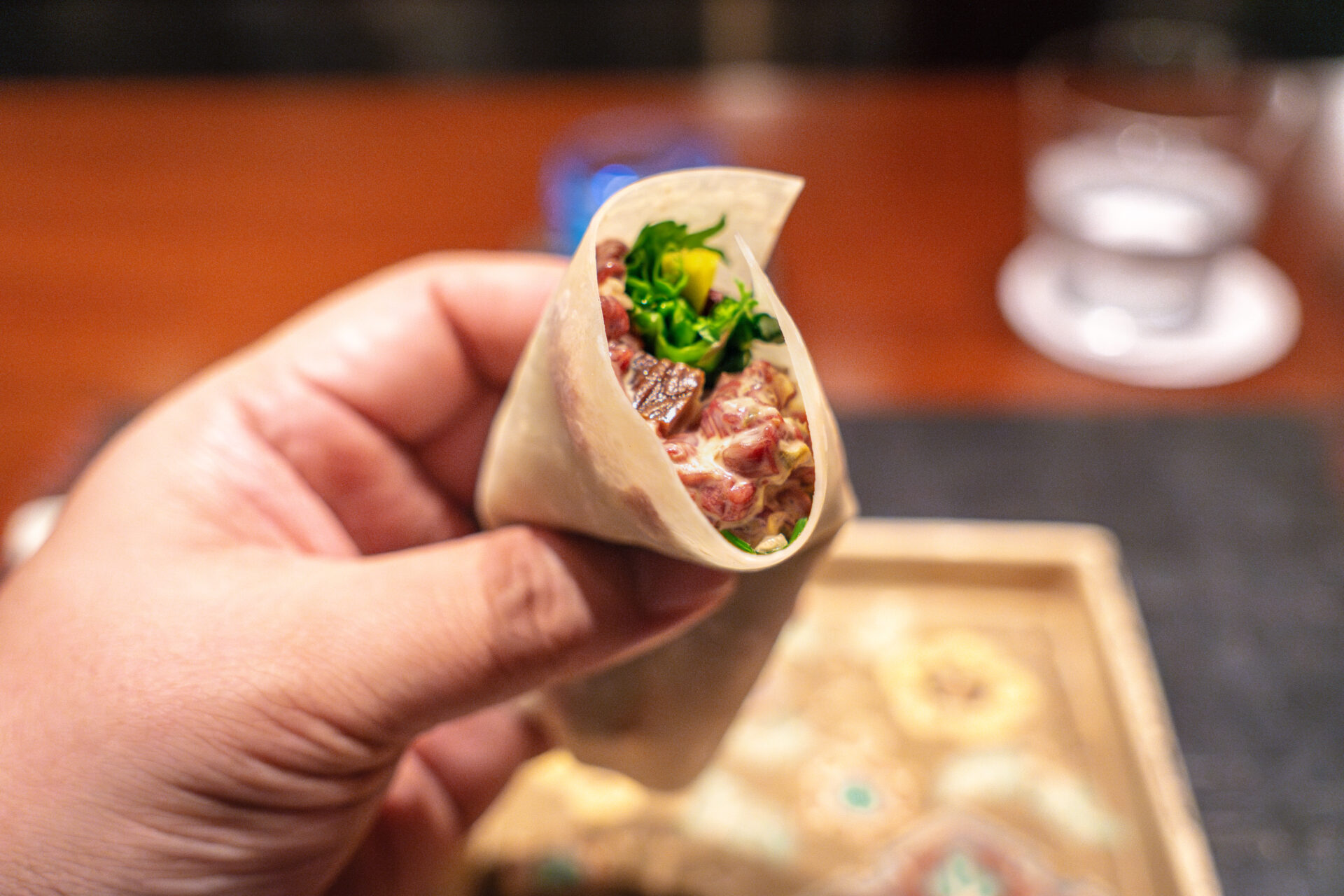
Pairing:
“Poolside” by Shobbrook Wines from Barossa, Australia.
A rosé based primarily on Grenache, it offers bright strawberry and raspberry notes, a refreshing palate, and subtle hints of spice and smokiness—a wine full of layered nuance.
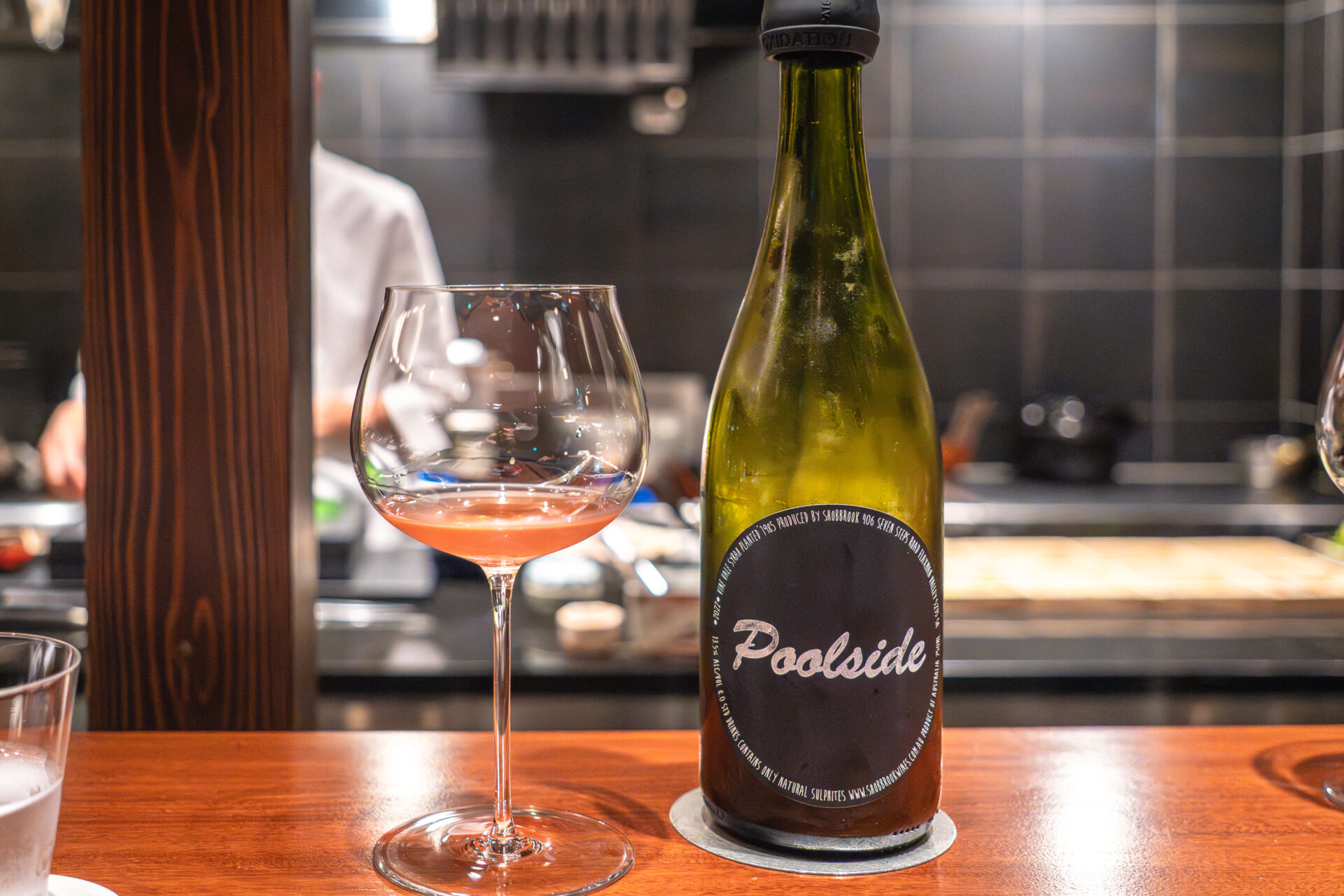
Nodoguro from Tsushima
The blackthroat seaperch (nodoguro) from Tsushima was crusted with finely crushed rice on the skin side and grilled over charcoal to a fragrant, crisp finish.
The crispy skin and rich, fatty flesh created a striking contrast.
Beneath the fish, a consomme made from nodoguro bones was served, with fresh spring vegetables.
The harmony of smokiness, umami, and seasonal brightness deepened with every bite.
A memorable dish that quietly showcased the precision of fire and broth.
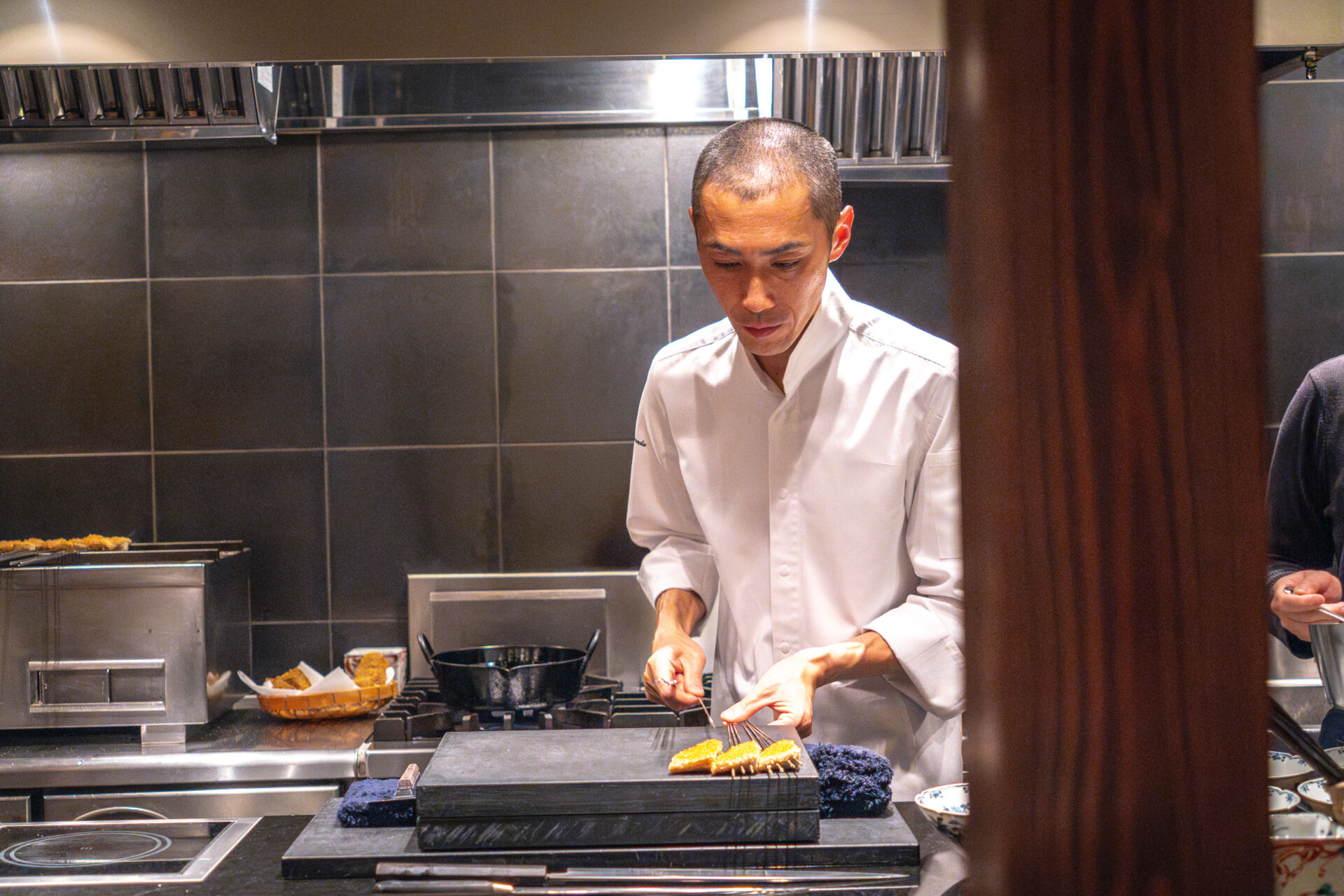
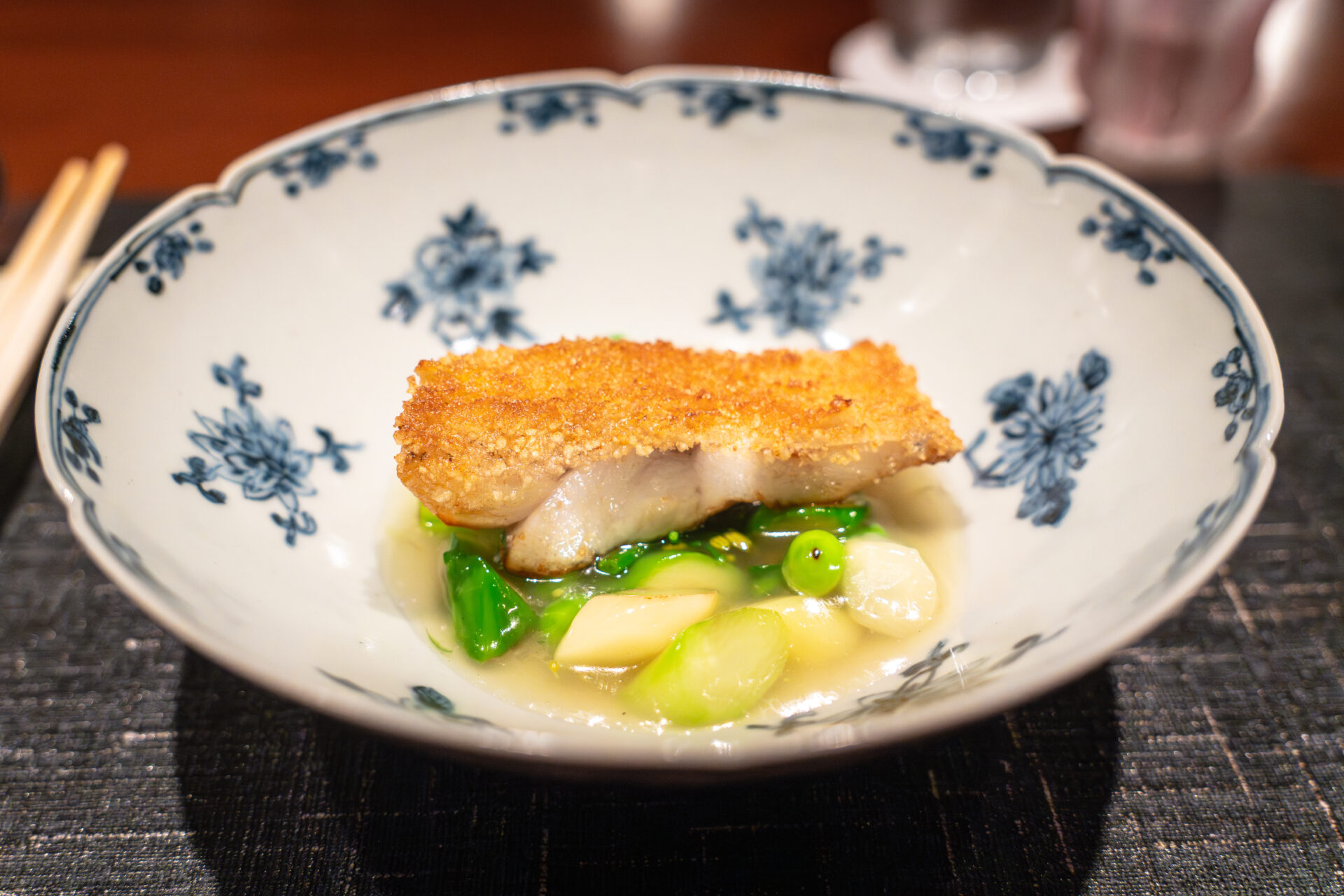
Afterward, a selection of vividly colored sake vessels was presented—each crafted by the renowned glass artist Kyōhei Fujita.
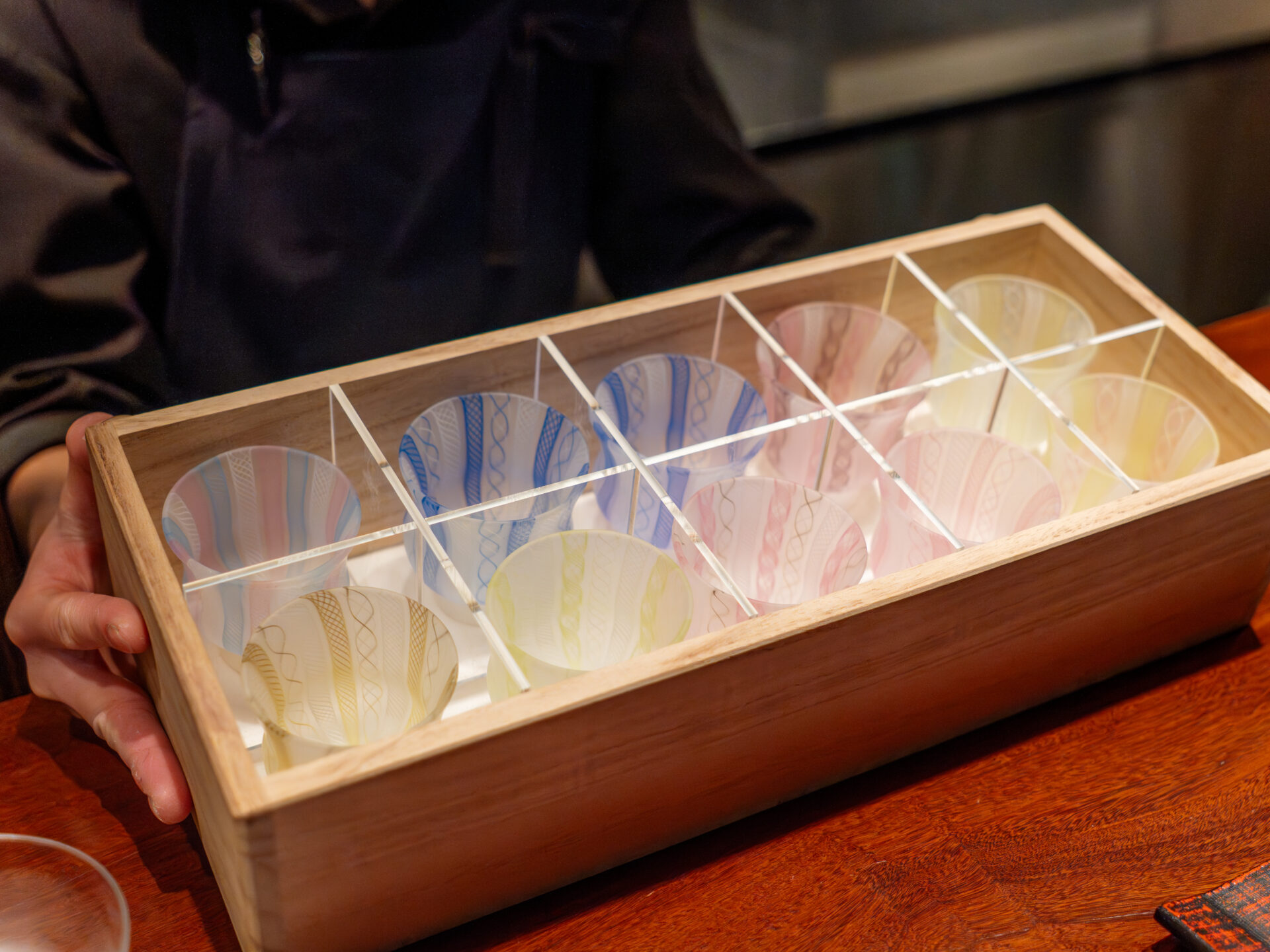
Pairing:
“Jōzan” from Jōzan Shuzō in Yamagata Prefecture.
With a gentle sweetness from the rice and a clean, dry finish, it highlighted the fat of the nodoguro while drawing in a refreshing aftertaste.
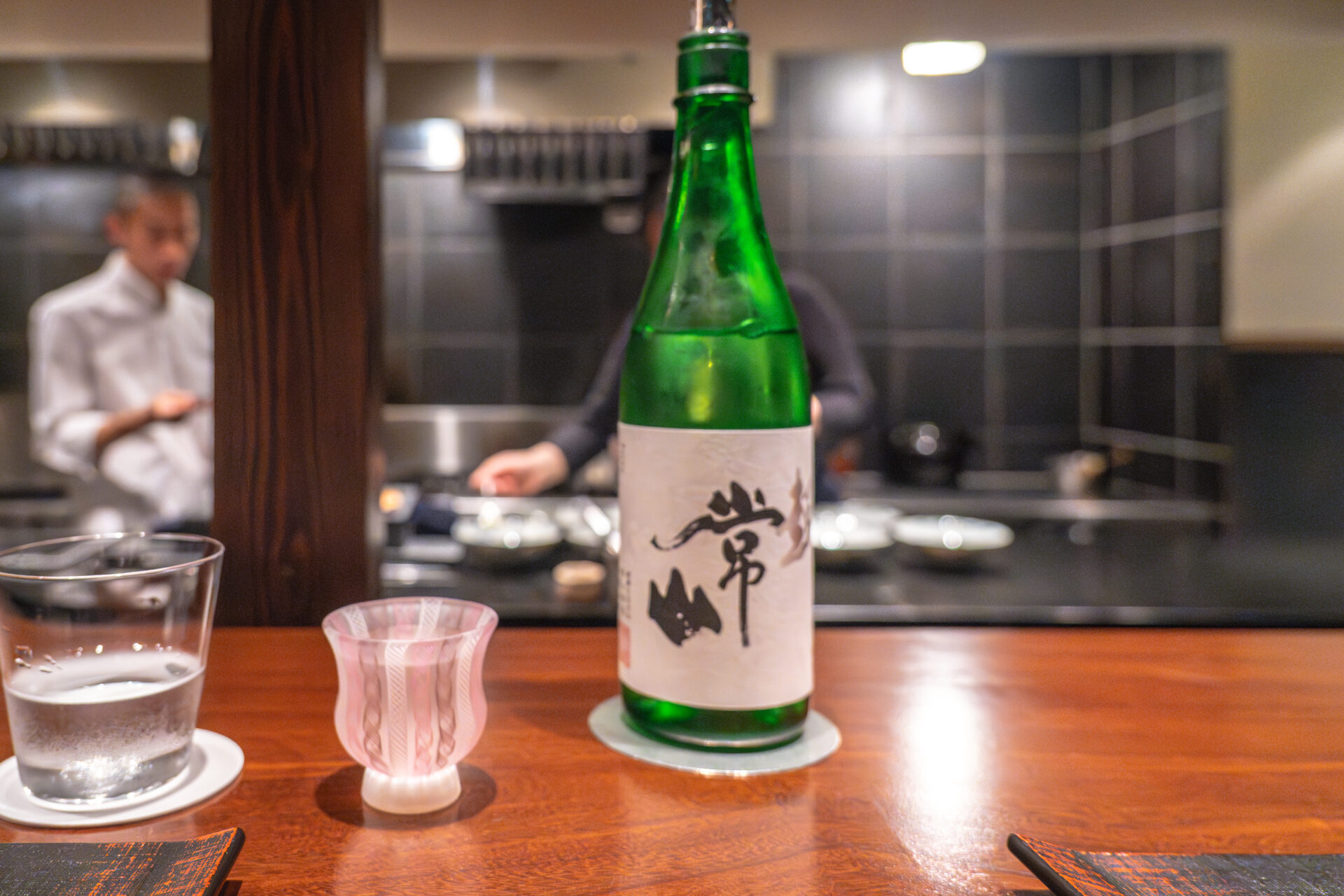
Chilled Udon with Clam and Shiso
Before the main course, a refreshing cold dish appeared—chilled udon-style noodles.
On top sat a plump clam (hamaguri), and the noodles, crafted by Nagao Seimen in Ukiha, Fukuoka, had a pleasingly chewy texture resembling handmade udon.
The clam dashi was infused with a touch of shiso paste, giving the dish a refreshing aroma and flavor.
When stirred before eating, the umami and fragrance enveloped the noodles in gentle harmony.
A dish that reset the palate and spirit, offering a moment of lightness before the main course.
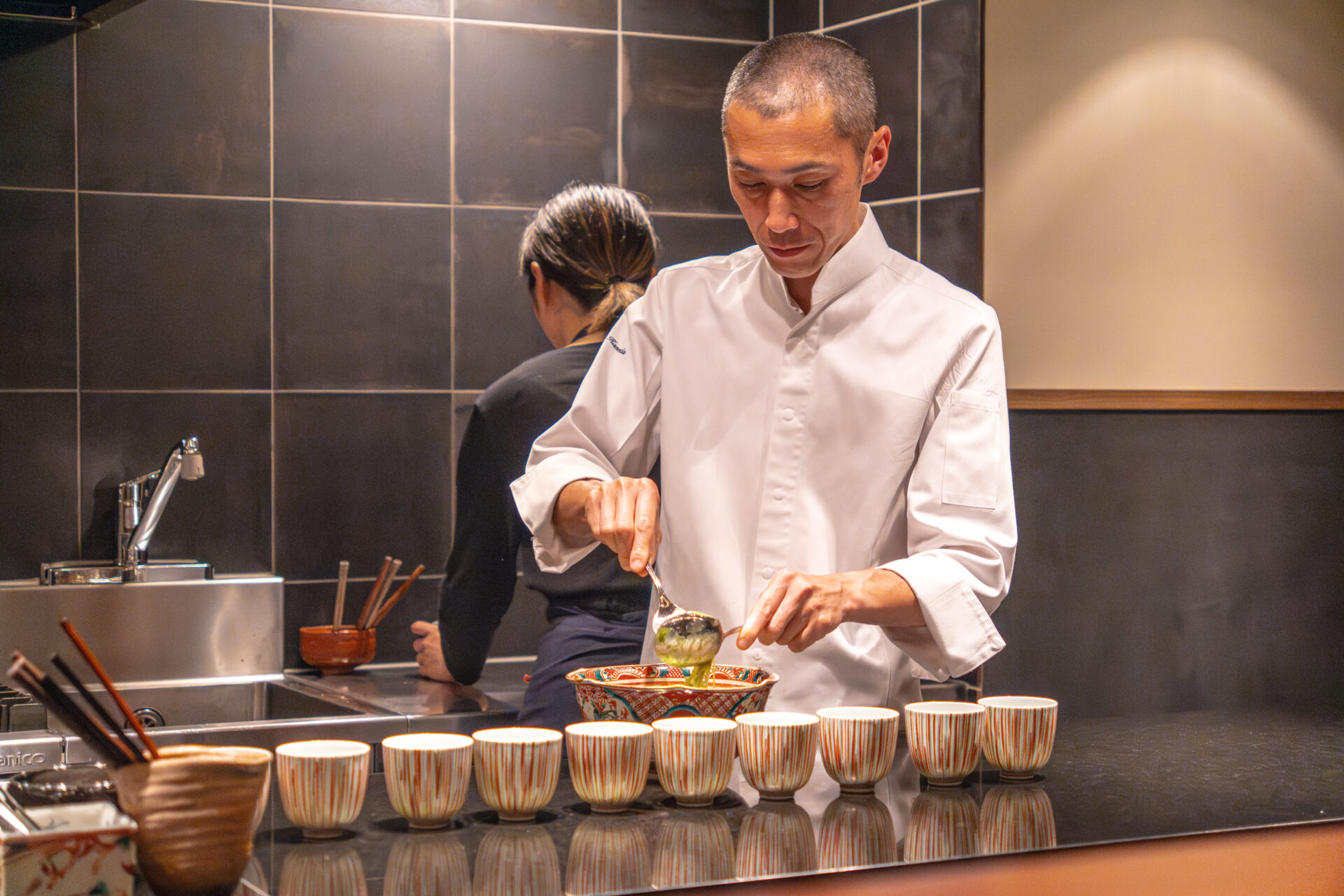
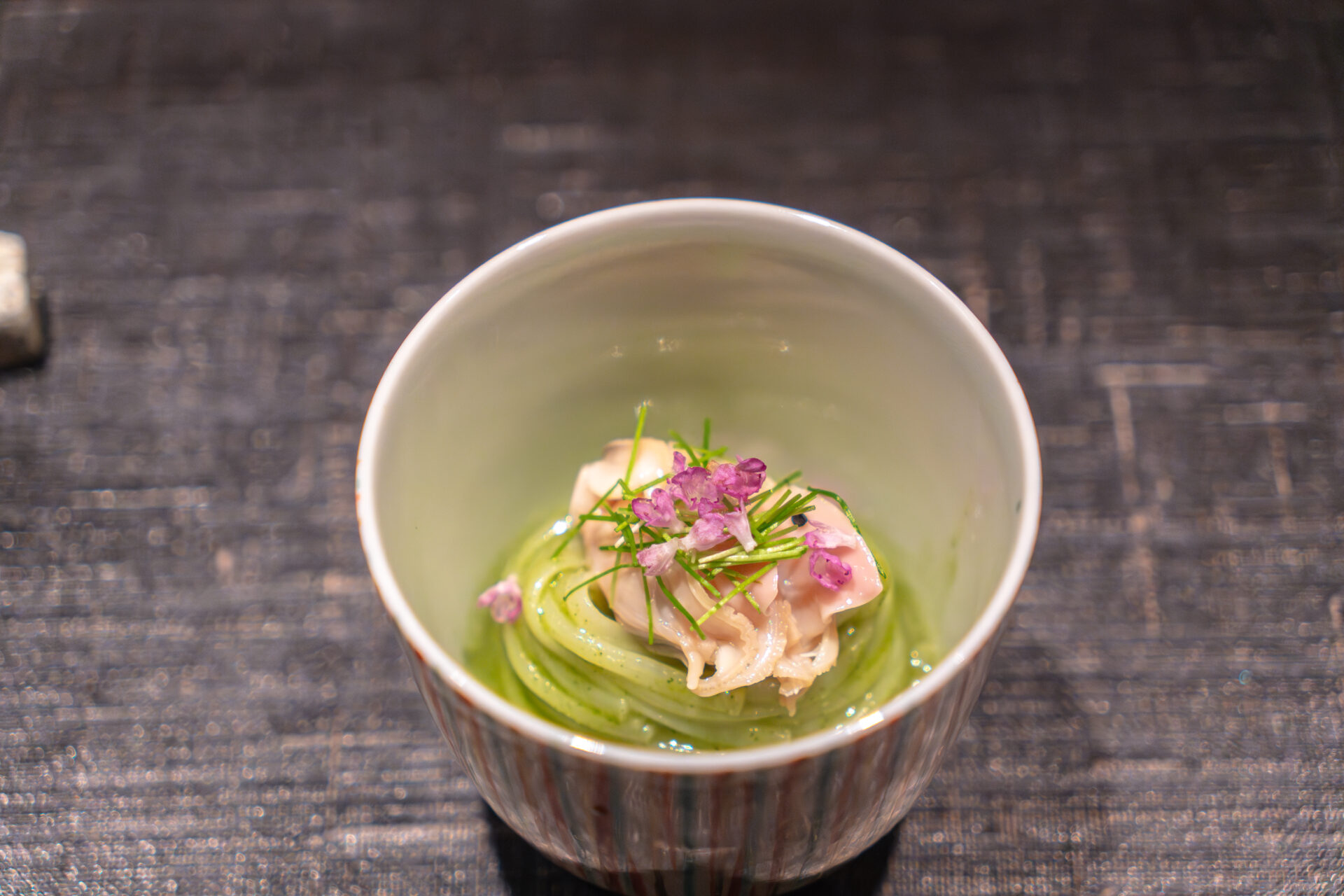
Nozaki Beef Fillet Cutlet
The main course: beef fillet cutlet made with Nozaki Wagyu.
Despite being breaded and fried, the fine-grained red meat remained moist and incredibly tender, releasing rich umami with every bite.
It was paired with a sauce made from black rice vinegar from Yame, which added a mellow acidity and rounded depth that brought balance and focus to the dish.
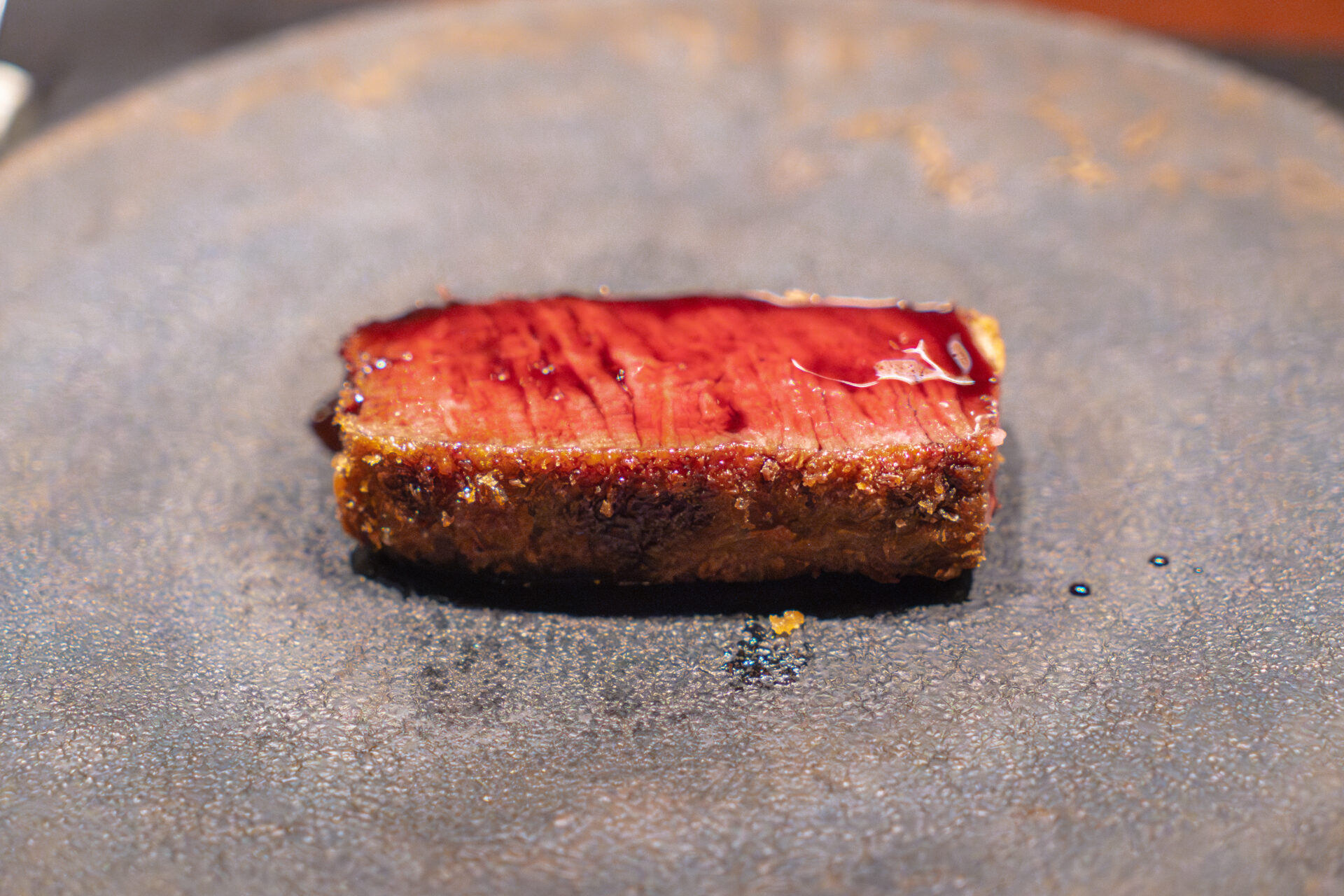
Pairing:
Rosso di Montalcino 2021 from Ridolfi.
Its supple acidity, violet aroma, and moderate tannins paired beautifully with the smoky notes of the cutlet and the tang of the black vinegar, complementing the beef’s richness with refined elegance.
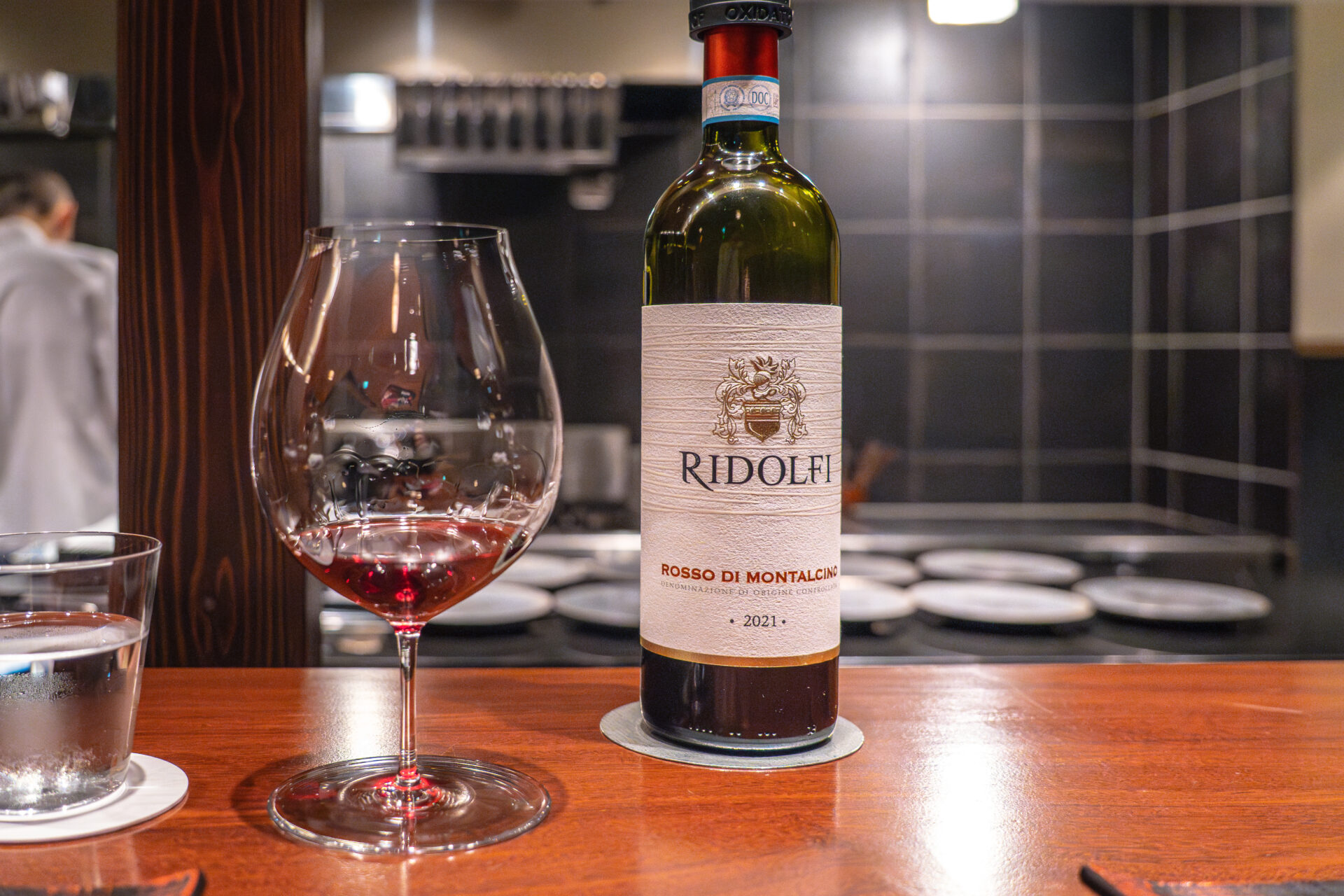
Takezaki Crab Spice Curry
The rice dish that closed the savory portion of the course was a spice curry made with Takezaki crab.
It subtly hinted at Chef Kaneda’s time training at Gaggan in Bangkok, adding a delicate infusion of spice into an otherwise Japanese progression.
The sweetness of the crab and the layered spices came together in harmony, leaving a surprising and memorable impression at the course’s end.
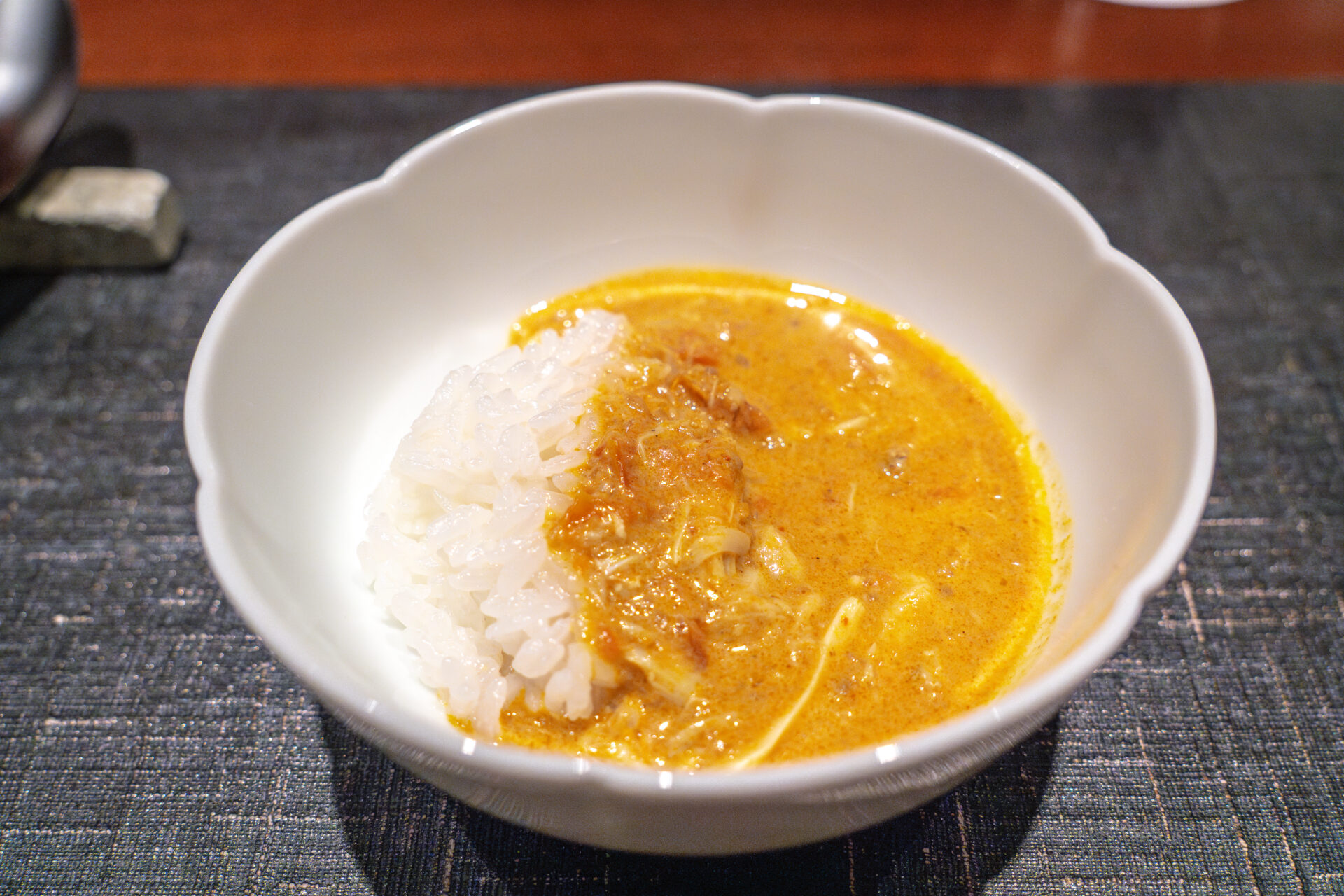
Dessert & Finale
Ao’s Signature Sugar Sculpture
Dessert was Ao’s signature—an intricate sugar sculpture.
Inside, it held a mousse of mandarin orange and yogurt.
With the back of a spoon, the sugar shell could be gently cracked open, shattering lightly with a satisfying crispness.
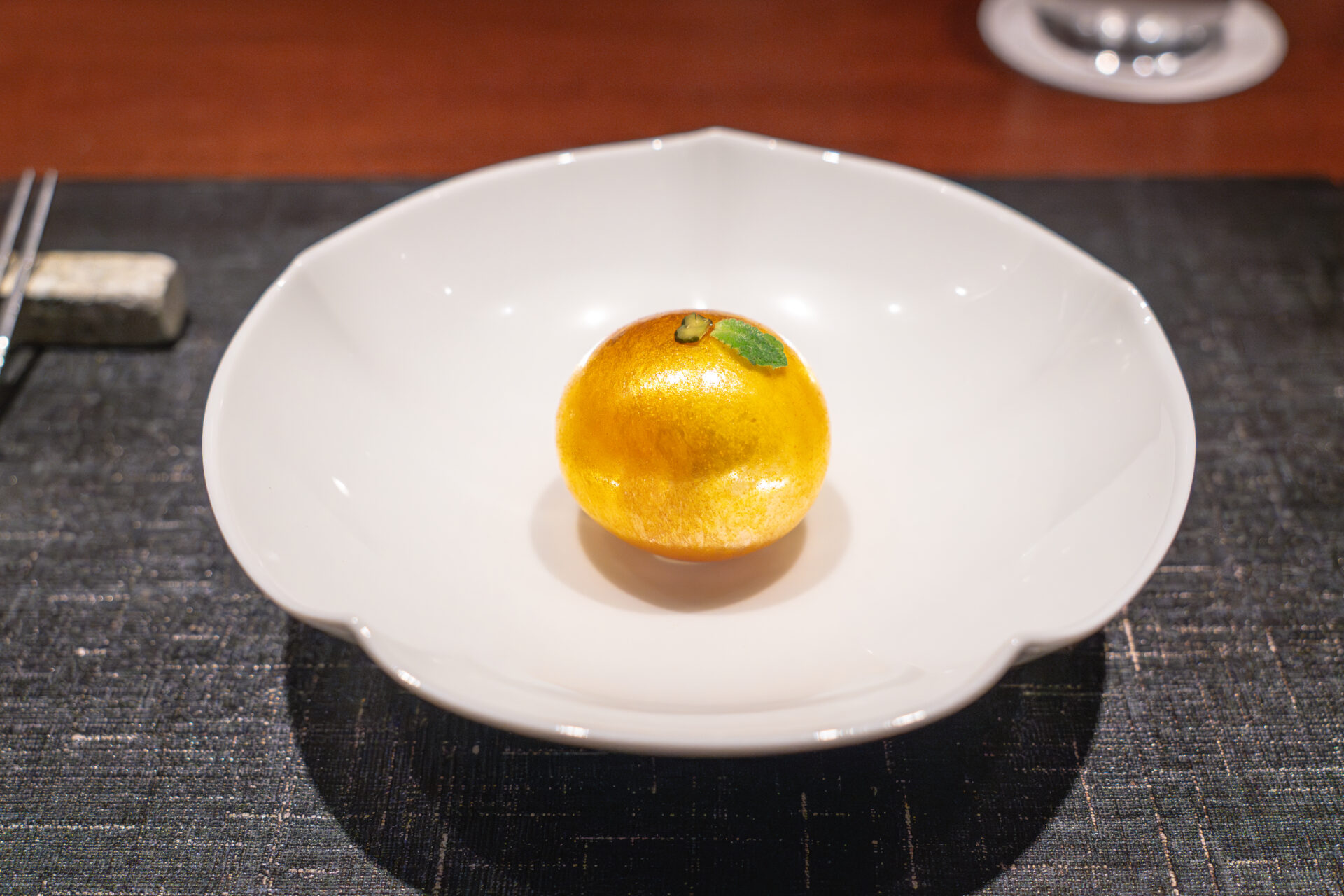
A refreshing aroma wafted out, and on the plate were also fresh dekopon citrus and yogurt ice cream.
The balance of sweetness, acidity, and textural contrast left a beautifully clean aftertaste.
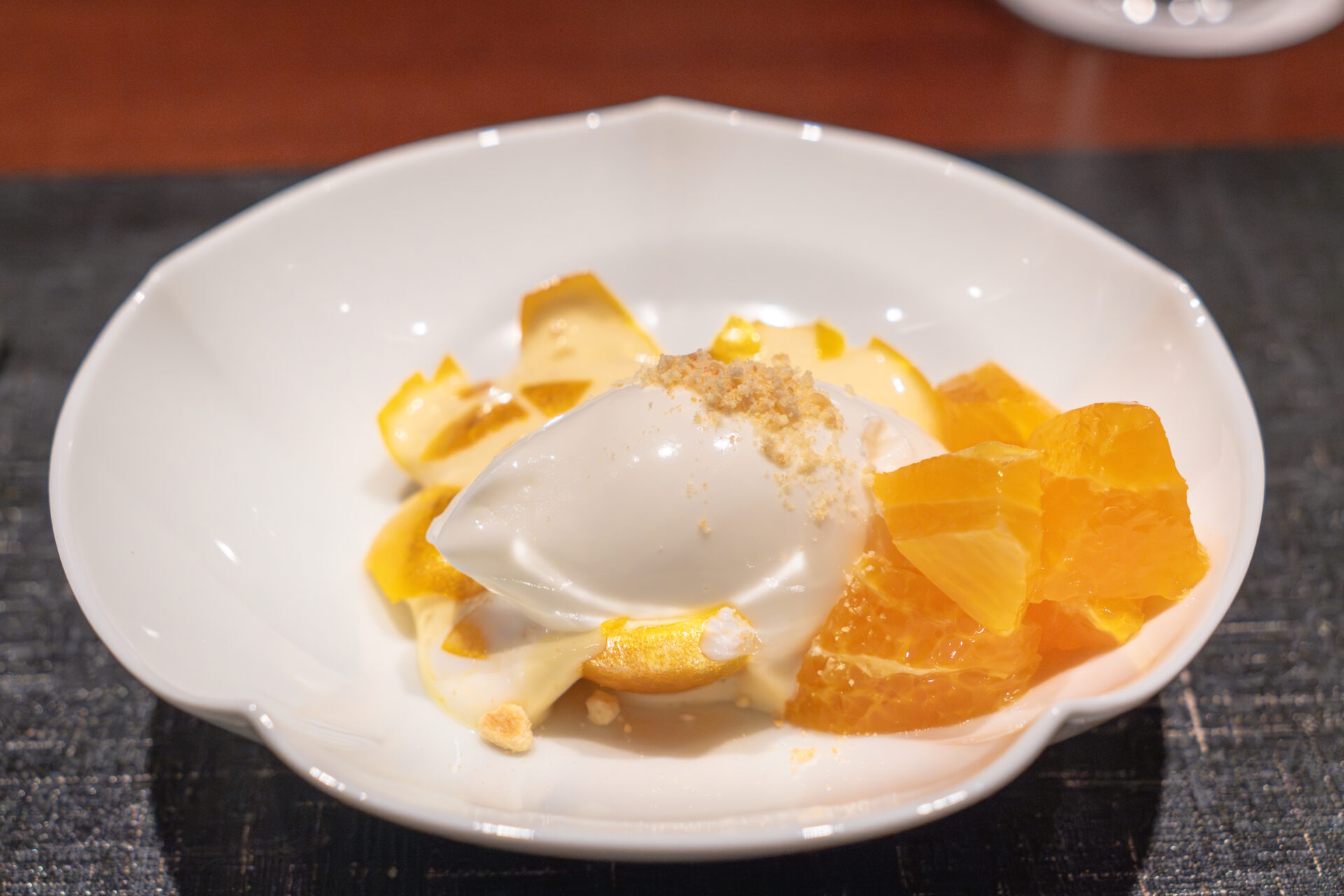
Pairing:
“geek cello Hyuganatsu”, a citrus liqueur.
Mild in sweetness with a clear, lifting aroma of hyuganatsu, it echoed the citrus and yogurt inside the sugar shell, leaving a pure and graceful final impression.
Ending the meal with this kind of “sweetness with space” felt perfectly in tune with Ao’s ethos.
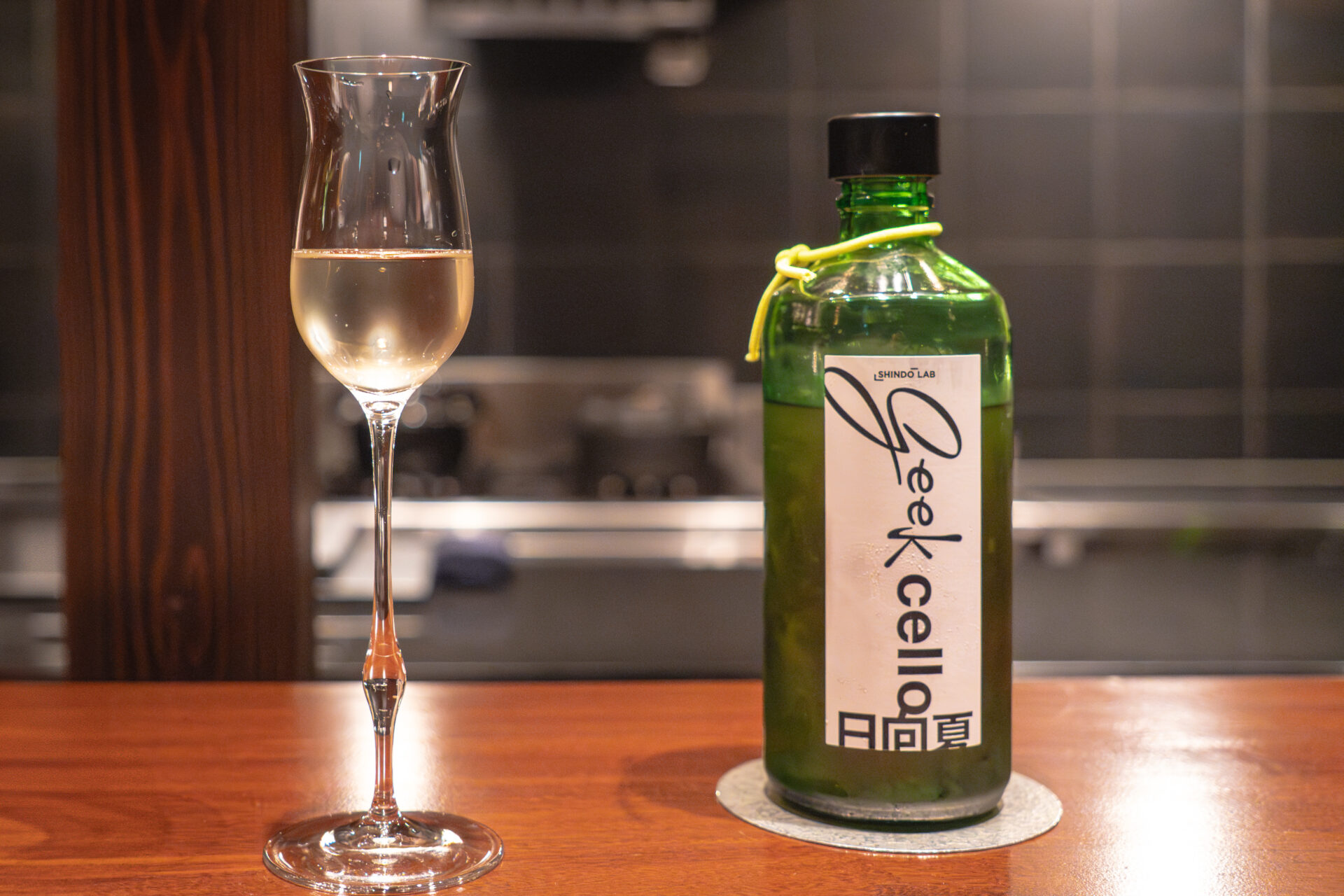
Yōkan as Clear as Water
The final bite was a translucent water-like yōkan.
Its appearance was nearly clear, and it melted on the tongue as delicately as water itself.
With the barest whisper of sweetness, it was less a dessert than an echo—a quiet conclusion that felt like savoring the very memory of flavor.
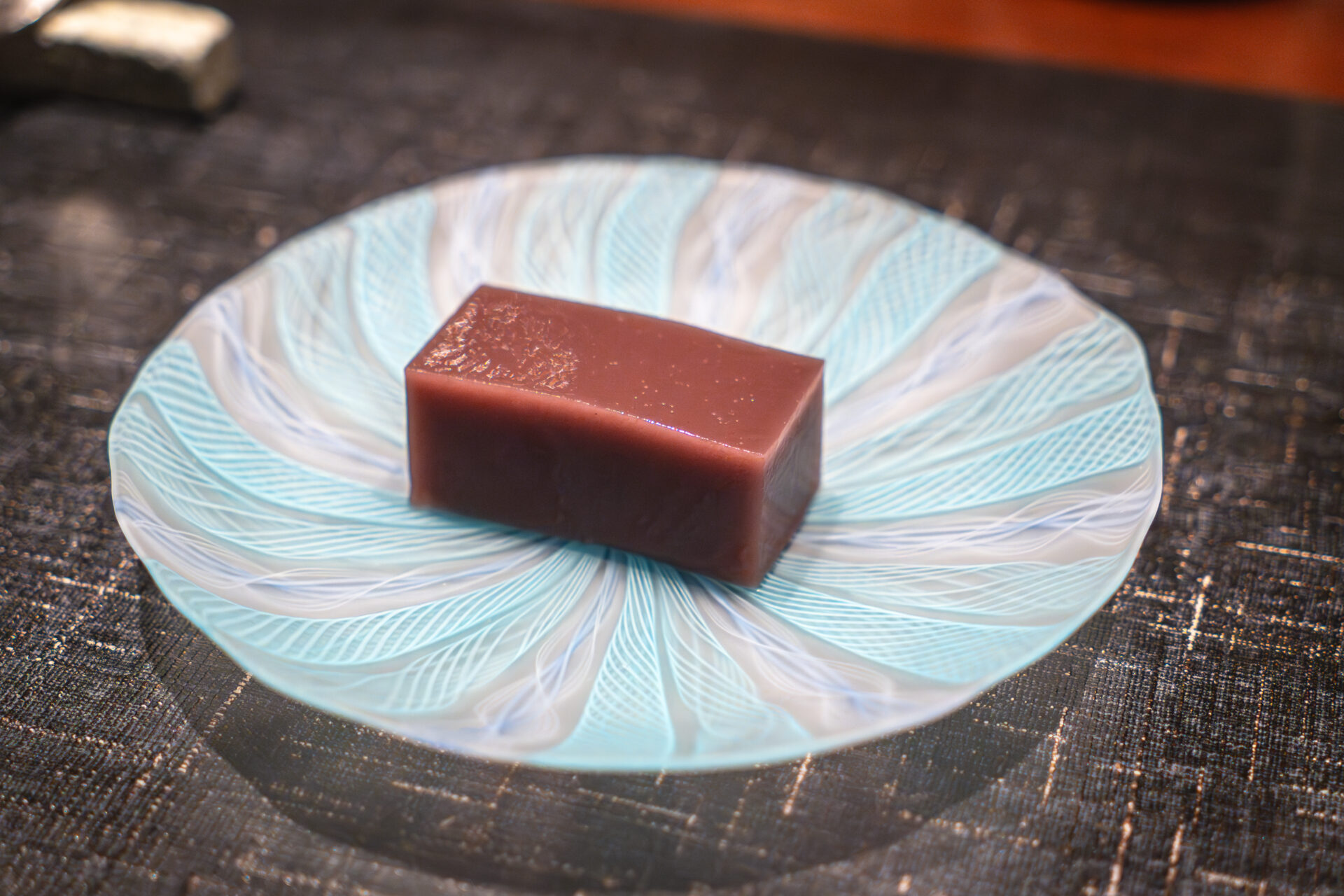
Summary & Impressions
It always begins quietly—before you realize it, you’re drawn in, deeply and fully.
There’s no forced tension, no exaggerated excitement, and yet, with each course, your posture naturally straightens.
The way heat is applied, the precision of the knife, the structure of each dish—
nothing is excessive, nothing is lacking. And yet, nothing feels routine.
Whether it’s wrapping the shabu-shabu with nuta or folding horse meat in your hands,
even your own gestures become part of the culinary expression.
You don’t simply “eat”—you’re gently guided through the act itself.
There’s room to play, but no wavering.
The menu is varied, but the vision never strays.
The dashi, the acidity, the fragrance—each is present not for effect, but because it belongs.
It’s never flamboyant, and yet, it lingers in your memory for a reason you feel rather than name.
More often than not, you realize the depth of the experience on the way home.
A passing aroma or aftertaste quietly brings a dish from earlier back to mind.
And once again, you fall for it.
It was that kind of night.
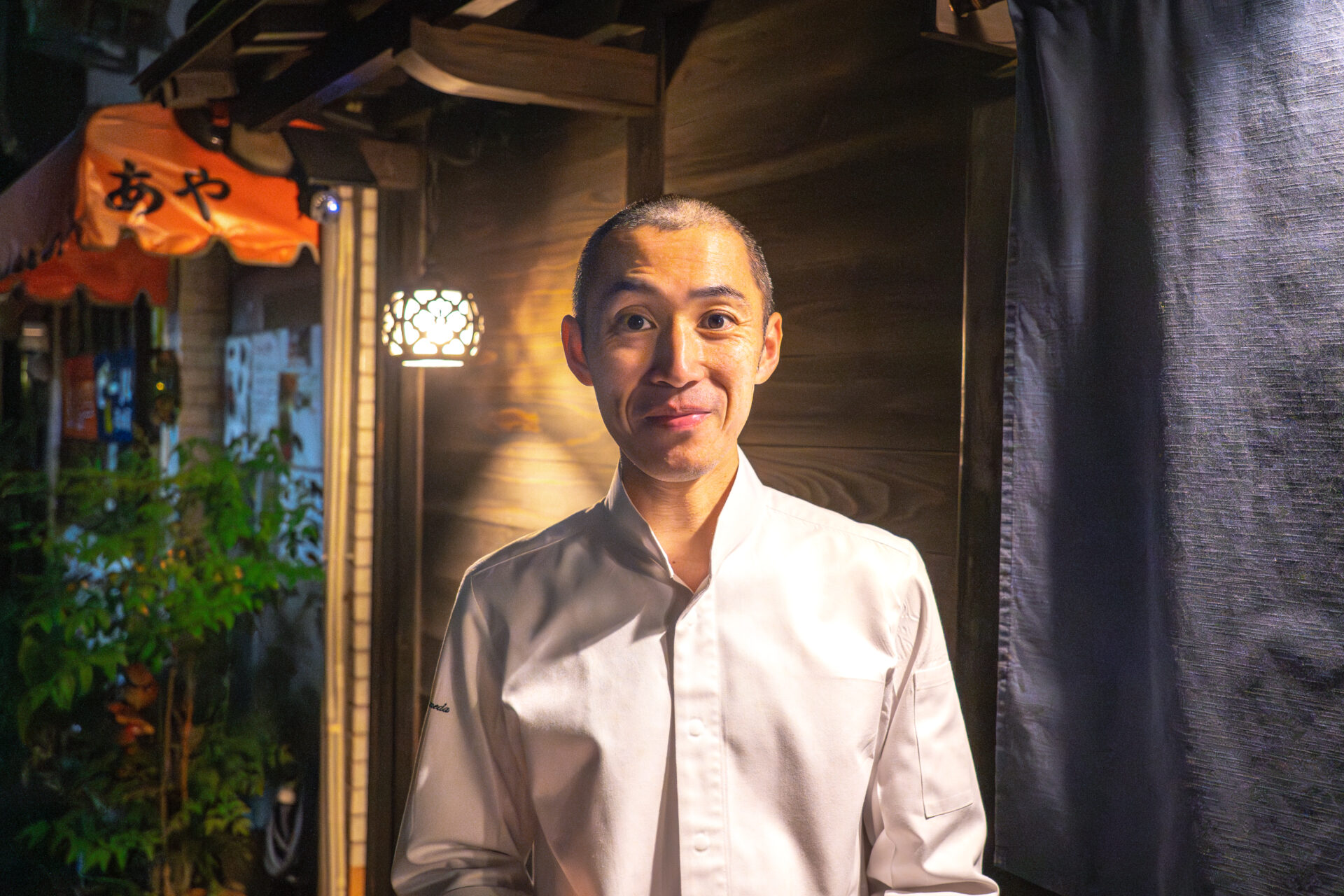
Reservations & Access
Reservation Information
Ao operates by reservation only.
Bookings are accepted exclusively via the online reservation form on the official website.
Reservations cannot be made by phone or email.
Reservation availability is updated on the restaurant’s website as needed,
but as of now, bookings for 2026 are already closed,
and the schedule for future reservations remains undecided.
Please note:
-
Waitlists are not accepted
-
Updates on cancellations or openings are shared only via Instagram
Cancellation policy:
-
Within 1 week of reservation: 50% of course fee
-
Same-day cancellation: 100% of course fee
Access
Address:
4‑11‑3 Narayamachi, Hakata-ku, Fukuoka-shi, Fukuoka
Nearest stations:
-
Nakasukawabata Station (Kūkō Line) – approx. 5–6 min walk
-
Gofukumachi Station (Hakozaki Line) – approx. 6 min walk
Opening Hours
Dinner only:
-
Doors open at 17:45, with the course starting promptly at 18:00
-
Please note: start time may vary depending on the day
Closed:
-
Irregular holidays
- TAGS

